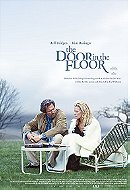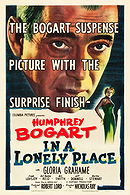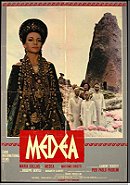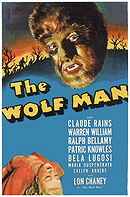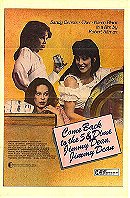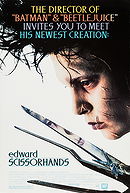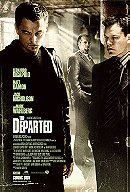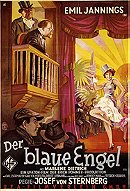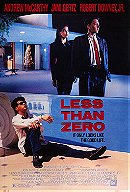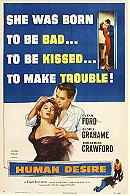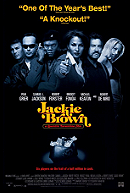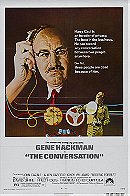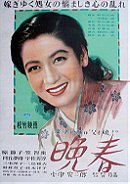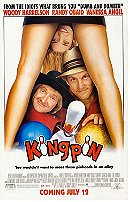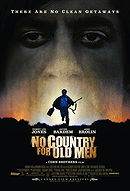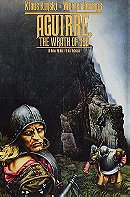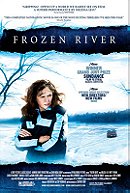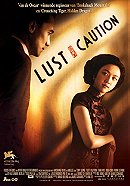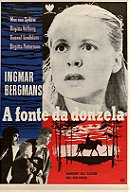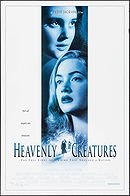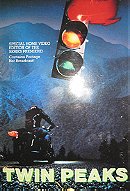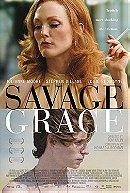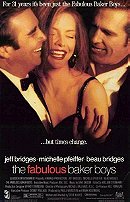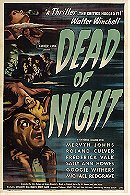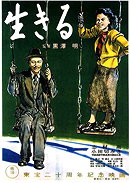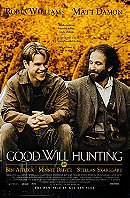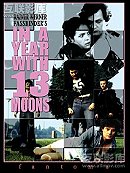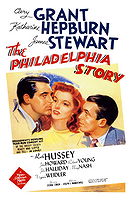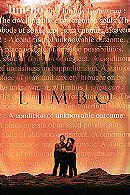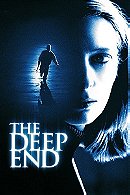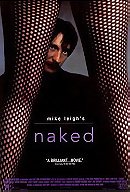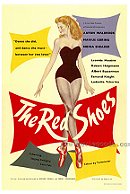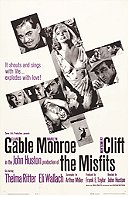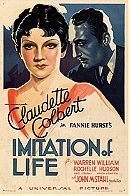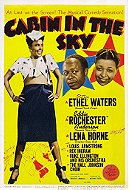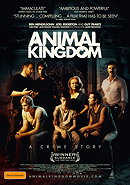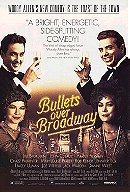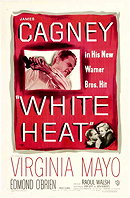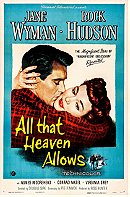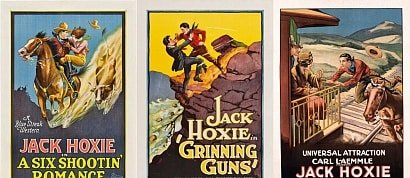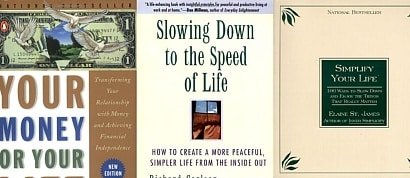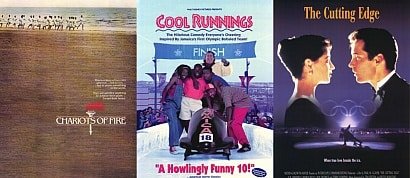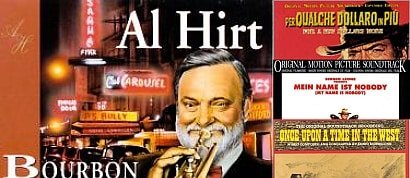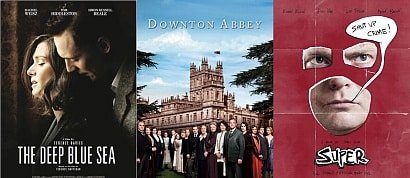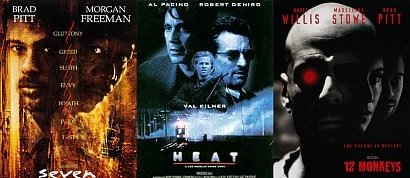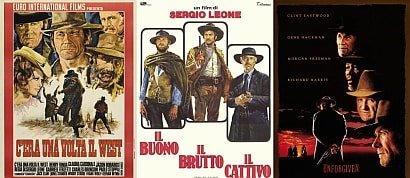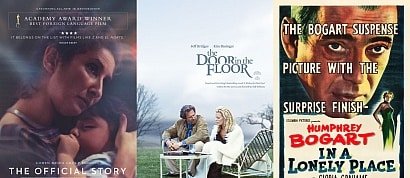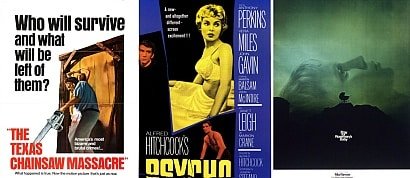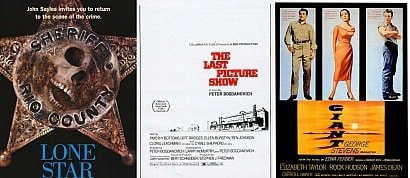PopMatter's Essential Film Performances - 2010
Sort by:
Showing 50 items
Decade:
Rating:
List Type:
PopMatters follows up last year's hugely popular 100 Essential Female and Male Performances feature with 50 additions to the essentials list.
The Official Story (1985)
UNDER THE RADAR
Norma Aleandro
When Aleandro was nominated for a Best Supporting Actress Oscar for Gaby: A True Story (1987), quite a few people were surprised, as the role is minimal and Aleandro has no “Oscar” moments in the film. There was little doubt, though, that the nomination was compensation for the Oscar’s failure to nominate Aleandro for her extraordinary performance two years prior in Puenzo’s The Official Story (La Historia Oficial ). As Alicia, an adoptive mother and wife of an affluent politician who slowly comes to realize that the orphaned child she and her husband have adopted is the child of murdered dissidents, and that her husband is complicit in the death of the young girl’s biological parents, Aleandro is riveting to watch as the camera lingers to capture her extraordinarily expressive face. Whether laughing in a café with friends or walking out on the husband who has just tortured her, she dominates the scene.
Considering the nature of what her character endures, lesser actresses would have made Alicia larger than life, slinging emotions all over the screen. However, Aleandro plays it all internally, controlling the fury and fear seizing Alicia’s thoughts. The Official Story is equal parts family drama, political thriller, and feminist tale, providing the type of female role that actresses crave. In Aleandro, the film has found its Alicia, and consequently, all parts of the film come to life.
-Michael Abernethy
Norma Aleandro
When Aleandro was nominated for a Best Supporting Actress Oscar for Gaby: A True Story (1987), quite a few people were surprised, as the role is minimal and Aleandro has no “Oscar” moments in the film. There was little doubt, though, that the nomination was compensation for the Oscar’s failure to nominate Aleandro for her extraordinary performance two years prior in Puenzo’s The Official Story (La Historia Oficial ). As Alicia, an adoptive mother and wife of an affluent politician who slowly comes to realize that the orphaned child she and her husband have adopted is the child of murdered dissidents, and that her husband is complicit in the death of the young girl’s biological parents, Aleandro is riveting to watch as the camera lingers to capture her extraordinarily expressive face. Whether laughing in a café with friends or walking out on the husband who has just tortured her, she dominates the scene.
Considering the nature of what her character endures, lesser actresses would have made Alicia larger than life, slinging emotions all over the screen. However, Aleandro plays it all internally, controlling the fury and fear seizing Alicia’s thoughts. The Official Story is equal parts family drama, political thriller, and feminist tale, providing the type of female role that actresses crave. In Aleandro, the film has found its Alicia, and consequently, all parts of the film come to life.
-Michael Abernethy
The Door in the Floor (2004)
FROM PAGE TO SCREEN
Kim Basinger
The Door in the Floor, based on John Irving’s 1998 novel A Widow For One Year, isn’t exactly a well-known film. It certainly didn’t gain the fame or critical acclaim of awards magnet L.A. Confidential. Kim Basinger’s turn as a high class call girl in Curtis Hanson’s throwback may have been the racehorse that earned her laurels including an Oscar, but it is her portrayal of the frozen-with-grief Marion Cole in The Door in the Floor that showed viewers something even more unique- a fresh, layered dissection of a bereaved mother.
Basinger and costar Jeff Bridges portray a separated couple grieving the loss of two sons, an arduous balancing act made even less stable when a new young man is sent to stay with them for the summer. Though never vocalized, it soon becomes clear that Eddie (Jon Foster) is serving as somewhat of a replacement son for each parent. Basinger doesn’t adhere to the usual methods of portraying grief. She’s doesn’t drink, rarely cries, and never succumbs to violent outbursts of any kind. Instead, she stares numbly out at the ocean as the turn signal in her car blinks on and off. Her eyes become small and black, just as they do when someone alludes to “the accident”. Her misery is unparalleled, but Basinger keenly chooses to let her subtle actions depict the character’s plight instead of showy, nonsensical gestures. It’s a performance that draws little or no attention to itself, but stands as calculated and crafted as any. It’s one the Academy and audiences should reward, but rarely do.
-Ben Travers
Kim Basinger
The Door in the Floor, based on John Irving’s 1998 novel A Widow For One Year, isn’t exactly a well-known film. It certainly didn’t gain the fame or critical acclaim of awards magnet L.A. Confidential. Kim Basinger’s turn as a high class call girl in Curtis Hanson’s throwback may have been the racehorse that earned her laurels including an Oscar, but it is her portrayal of the frozen-with-grief Marion Cole in The Door in the Floor that showed viewers something even more unique- a fresh, layered dissection of a bereaved mother.
Basinger and costar Jeff Bridges portray a separated couple grieving the loss of two sons, an arduous balancing act made even less stable when a new young man is sent to stay with them for the summer. Though never vocalized, it soon becomes clear that Eddie (Jon Foster) is serving as somewhat of a replacement son for each parent. Basinger doesn’t adhere to the usual methods of portraying grief. She’s doesn’t drink, rarely cries, and never succumbs to violent outbursts of any kind. Instead, she stares numbly out at the ocean as the turn signal in her car blinks on and off. Her eyes become small and black, just as they do when someone alludes to “the accident”. Her misery is unparalleled, but Basinger keenly chooses to let her subtle actions depict the character’s plight instead of showy, nonsensical gestures. It’s a performance that draws little or no attention to itself, but stands as calculated and crafted as any. It’s one the Academy and audiences should reward, but rarely do.
-Ben Travers
In a Lonely Place (1950)
THE CLASSICS YOU SHOULD HAVE SEEN BY NOW
Humphrey Bogart
Many of director Nicholas Ray’s most memorable works were produced for Warner Brothers (Rebel Without a Cause, for instance) but his 1950 masterpiece In a Lonely Place was a Columbia Pictures effort for Humphrey Bogart’s Santana Productions, and it is Bogart’s stellar performance as down-on-his-luck studio scribe Dixon Steele that elevates the film from an edgy thriller to a rich and complex psychological portrait of a man haunted by internal demons that literally threaten the safety of all who stray within striking distance of him.
Both the tone and the subject (anger management and domestic violence) of Ray’s film are surprisingly modern, as is Bogart’s jaw-dropping performance; as contemporary director Curtis Hanson (L.A. Confidential) says in the mini-documentary In a Lonely Place: Revisited there is “an absence of acting” in Bogart’s work in the film, “an absence of technique… revealing things that perhaps he himself did not want to reveal… he looks physically ugly at times; we see his vulnerability, we see his fear, we see his needs.”
In the film (based on a novel by Dorothy B. Hughes) Steele is surrounded by sycophantic popcorn salesmen who don’t understand his moody temperament; they just want him to get his shit together and adapt a trashy bestseller novel for them. Rather than bother with reading the book himself, Dix convinces a star-struck hatcheck girl, Mildred, to accompany him home and tell him the story in her own words. When Mildred is found viciously murdered later that evening, Steele, who has a history of violence, becomes the prime suspect.
In a Lonely Place is a spot-on indictment of the film industry. Dix is an artist and the artist is powerless in Hollywood; when a man is dis-empowered, anger and aggression is sure to follow. In Hughes’ source novel Steele is a rapist and a serial killer but Ray changed that in the adaptation process because, as he said, he “was more interested in doing a film about the violence inside all of us, rather than a mass murder film or one about a psychotic”.
-Rodger Jacobs
Humphrey Bogart
Many of director Nicholas Ray’s most memorable works were produced for Warner Brothers (Rebel Without a Cause, for instance) but his 1950 masterpiece In a Lonely Place was a Columbia Pictures effort for Humphrey Bogart’s Santana Productions, and it is Bogart’s stellar performance as down-on-his-luck studio scribe Dixon Steele that elevates the film from an edgy thriller to a rich and complex psychological portrait of a man haunted by internal demons that literally threaten the safety of all who stray within striking distance of him.
Both the tone and the subject (anger management and domestic violence) of Ray’s film are surprisingly modern, as is Bogart’s jaw-dropping performance; as contemporary director Curtis Hanson (L.A. Confidential) says in the mini-documentary In a Lonely Place: Revisited there is “an absence of acting” in Bogart’s work in the film, “an absence of technique… revealing things that perhaps he himself did not want to reveal… he looks physically ugly at times; we see his vulnerability, we see his fear, we see his needs.”
In the film (based on a novel by Dorothy B. Hughes) Steele is surrounded by sycophantic popcorn salesmen who don’t understand his moody temperament; they just want him to get his shit together and adapt a trashy bestseller novel for them. Rather than bother with reading the book himself, Dix convinces a star-struck hatcheck girl, Mildred, to accompany him home and tell him the story in her own words. When Mildred is found viciously murdered later that evening, Steele, who has a history of violence, becomes the prime suspect.
In a Lonely Place is a spot-on indictment of the film industry. Dix is an artist and the artist is powerless in Hollywood; when a man is dis-empowered, anger and aggression is sure to follow. In Hughes’ source novel Steele is a rapist and a serial killer but Ray changed that in the adaptation process because, as he said, he “was more interested in doing a film about the violence inside all of us, rather than a mass murder film or one about a psychotic”.
-Rodger Jacobs
JxSxPx's rating:


FROM PAGE TO SCREEN
Maria Callas
She doesn’t sing a note in the film, but acclaimed opera singer, Callas uses her years of stage training to telegraph powerful emotion delivered via facial expressions and body language in Medea. Passolini’s Medea, aside from the basic storyline lifted from classical mythology, certainly isn’t Euripides’ Medea or even the sorceress found in Seneca’s dramatization. For all of the glorious prose and acting stretches that the two ancient playwrights afforded their leads, Passolini’s rendering of Medea suffers in near silence throughout the course of the film’s depiction of ritual, tradition and myth.
Callas makes the most of every scene, conveying emotion—or a lack of—through her magnificent, kohl-rimmed eyes. When first introduced to a pre-Jason Medea, she presides over a ritual human sacrifice, carrying out her duties as priestess with mystical, dead-eyed acceptance. When she must turn the blade on her brother to save her lover, she connects her role as priestess with the fortitude required to exact the deed, dominated by visible resolve and remorse. Later in the film, Callas as an older Medea—spurned by her husband for a younger, more profitable marriage—concocts the mother (pardon the pun) of all revenge schemes with a righteous anger simmering below the surface. Callas inexplicably makes Medea a sympathetic figure in spite of her heinous acts. As she sends her children to do her bidding—and ultimately to their doom—her subtly satisfied glimmer of revenge is visible, but buried beneath the layers of a desperate, yet still-regal housewife and tender, grieving mother.
-Lana Cooper
Maria Callas
She doesn’t sing a note in the film, but acclaimed opera singer, Callas uses her years of stage training to telegraph powerful emotion delivered via facial expressions and body language in Medea. Passolini’s Medea, aside from the basic storyline lifted from classical mythology, certainly isn’t Euripides’ Medea or even the sorceress found in Seneca’s dramatization. For all of the glorious prose and acting stretches that the two ancient playwrights afforded their leads, Passolini’s rendering of Medea suffers in near silence throughout the course of the film’s depiction of ritual, tradition and myth.
Callas makes the most of every scene, conveying emotion—or a lack of—through her magnificent, kohl-rimmed eyes. When first introduced to a pre-Jason Medea, she presides over a ritual human sacrifice, carrying out her duties as priestess with mystical, dead-eyed acceptance. When she must turn the blade on her brother to save her lover, she connects her role as priestess with the fortitude required to exact the deed, dominated by visible resolve and remorse. Later in the film, Callas as an older Medea—spurned by her husband for a younger, more profitable marriage—concocts the mother (pardon the pun) of all revenge schemes with a righteous anger simmering below the surface. Callas inexplicably makes Medea a sympathetic figure in spite of her heinous acts. As she sends her children to do her bidding—and ultimately to their doom—her subtly satisfied glimmer of revenge is visible, but buried beneath the layers of a desperate, yet still-regal housewife and tender, grieving mother.
-Lana Cooper
JxSxPx's rating:


The Wolf Man (1941)
THE DARK SIDE
Lon Chaney Jr.
As the prodigal son/awkward blue-blood and unfortunate victim of a werewolf bite that rendered him cursed, Chaney stepped out of his father’s shadow and created one of the most memorable—if not sorely underrated—movie monster performances of all time. Portraying the likeable Larry Talbot, Chaney’s character returns from America following the death of his brother in WWI to his family’s British estate. Although Chaney towered over his on-screen father (the equally good Claude Rains) and possessed a distinctly American accent compared to Sir John Talbot’s veddy British tone, the chemistry between the two men made their father-son relationship utterly believable.
Throughout the course of the film, Chaney contorts his features to express a gamut of emotions. When first introduced to the character of Larry Talbot, he’s a charming, happy-go-lucky young man. As a human coming to grips with his own fate, in a pivotal scene at the grave site of Bela (Bela Lugosi), the cursed werewolf who bit him, Chaney’s face is a study in subtlety of expression as he listens to the gypsy’s mother bid her son farewell. He lurks in the shadows, not as a menacing presence, but rather as a compassionate figure before giving way to a short, silent, yet explosive moment of grief. Chaney gifts the Wolf Man with an aura of tragedy, his performance superbly and sympathetically conveying Talbot’s terror at his own transformation, contrasted later with a visible sense of peace at his own demise.
-LC
Lon Chaney Jr.
As the prodigal son/awkward blue-blood and unfortunate victim of a werewolf bite that rendered him cursed, Chaney stepped out of his father’s shadow and created one of the most memorable—if not sorely underrated—movie monster performances of all time. Portraying the likeable Larry Talbot, Chaney’s character returns from America following the death of his brother in WWI to his family’s British estate. Although Chaney towered over his on-screen father (the equally good Claude Rains) and possessed a distinctly American accent compared to Sir John Talbot’s veddy British tone, the chemistry between the two men made their father-son relationship utterly believable.
Throughout the course of the film, Chaney contorts his features to express a gamut of emotions. When first introduced to the character of Larry Talbot, he’s a charming, happy-go-lucky young man. As a human coming to grips with his own fate, in a pivotal scene at the grave site of Bela (Bela Lugosi), the cursed werewolf who bit him, Chaney’s face is a study in subtlety of expression as he listens to the gypsy’s mother bid her son farewell. He lurks in the shadows, not as a menacing presence, but rather as a compassionate figure before giving way to a short, silent, yet explosive moment of grief. Chaney gifts the Wolf Man with an aura of tragedy, his performance superbly and sympathetically conveying Talbot’s terror at his own transformation, contrasted later with a visible sense of peace at his own demise.
-LC
JxSxPx's rating:


UNDER THE RADAR
Margaret Cho
Comedian Cho’s work in The Notorious C.H.O. is not just a great stand-up comedy performance, but a great work of performance art. She takes an obviously well-rehearsed, sometimes emotional routine and makes it sound as if she’s carrying on a conversation with her audience. Filmed in the aftermath of 9-11, Margaret waxes philosophically about what it means to be an American as a woman, an ethnic and sexual minority, and as a product of American consumer culture.
Cho’s delivery and well-timed pauses feel natural, as do her exaggeratedly horrified expressions towards her own activities and those around her. This makes Cho’s performance something you can’t merely listen to and get the full impact. You need to see her. As raw and raunchy as Cho’s routine is, she manages to covertly sneak in some poignant moments under the radar. She turns back the clock to her childhood days, noting hopefully that “Maybe someday… I could be an extra… on M*A*S*H.!”
While comedians tentatively bare their souls to some degree in their routines, Cho goes the extra mile and expresses some anger—tempered with good humor—at her parents, making mention of their unknowing affect on her development of an eating disorder. It’s a brave and real act. She obviously loves her family (who laugh with pride along with their daughter), but connects with her audience, comprised in part of social misfits of all stripes, impressing that we are ultimately a product of our environment, for better or worse. There is no shame in that, only humor.
-LC
Margaret Cho
Comedian Cho’s work in The Notorious C.H.O. is not just a great stand-up comedy performance, but a great work of performance art. She takes an obviously well-rehearsed, sometimes emotional routine and makes it sound as if she’s carrying on a conversation with her audience. Filmed in the aftermath of 9-11, Margaret waxes philosophically about what it means to be an American as a woman, an ethnic and sexual minority, and as a product of American consumer culture.
Cho’s delivery and well-timed pauses feel natural, as do her exaggeratedly horrified expressions towards her own activities and those around her. This makes Cho’s performance something you can’t merely listen to and get the full impact. You need to see her. As raw and raunchy as Cho’s routine is, she manages to covertly sneak in some poignant moments under the radar. She turns back the clock to her childhood days, noting hopefully that “Maybe someday… I could be an extra… on M*A*S*H.!”
While comedians tentatively bare their souls to some degree in their routines, Cho goes the extra mile and expresses some anger—tempered with good humor—at her parents, making mention of their unknowing affect on her development of an eating disorder. It’s a brave and real act. She obviously loves her family (who laugh with pride along with their daughter), but connects with her audience, comprised in part of social misfits of all stripes, impressing that we are ultimately a product of our environment, for better or worse. There is no shame in that, only humor.
-LC
JxSxPx's rating:


Purple Noon (1960)
FROM PAGE TO SCREEN
Alain Delon
Author Patricia Highsmith said that Delon was closest to what she had in mind for one of her most enigmatic creations, Tom Ripley. Matt Damon (who made the first 100 Essential Male Performances list) was a nerdy mega-creep in Anthony Minghella’s The Talented Mr. Ripley (1999), while Dennis Hopper’s Ripley in Wim Wenders’ 1977 twist, The American Friend, was more of a phantom haunting Bruno Ganz’s protagonist. In Clement’s vivid, luscious vision of Highsmith’s novel about class and masculine identity, Delon, in his first major film role, emerges as perhaps the definitive version of the character – aloof, beautiful and completely sociopathic, without remorse.
Looking very much like Jude Law’s Dickie Greenleaf from the 1999 version, Delon’s fey, flirting line-delivery when in the presence of Philippe Greenleaf (Maurice Ronet) make him even more subtly homoerotic than Damon’s overtly homosexual Ripley and with a lithe, bronzed dancer’s frame and a steady gracefulness his physical presence is appealing, sexy; particularly under the hot, white San Remo sun while yachting. Ripley is at first more than happy to simply bask in Philippe’s golden light, but soon his desire to actually be the young, rich expatriate becomes the impetus for a grand scheme in the wake of a terrible crime of passion. Though Ripley never means to cause the harm he does, his detachment from reality allows him to meticulously construct his own reality as a new man. In the face of all of his crimes, this Ripley remains distinctly cool, this misfit is alluring to the spectator, he makes us want to identify with him, to be him.
-Matt Mazur
Alain Delon
Author Patricia Highsmith said that Delon was closest to what she had in mind for one of her most enigmatic creations, Tom Ripley. Matt Damon (who made the first 100 Essential Male Performances list) was a nerdy mega-creep in Anthony Minghella’s The Talented Mr. Ripley (1999), while Dennis Hopper’s Ripley in Wim Wenders’ 1977 twist, The American Friend, was more of a phantom haunting Bruno Ganz’s protagonist. In Clement’s vivid, luscious vision of Highsmith’s novel about class and masculine identity, Delon, in his first major film role, emerges as perhaps the definitive version of the character – aloof, beautiful and completely sociopathic, without remorse.
Looking very much like Jude Law’s Dickie Greenleaf from the 1999 version, Delon’s fey, flirting line-delivery when in the presence of Philippe Greenleaf (Maurice Ronet) make him even more subtly homoerotic than Damon’s overtly homosexual Ripley and with a lithe, bronzed dancer’s frame and a steady gracefulness his physical presence is appealing, sexy; particularly under the hot, white San Remo sun while yachting. Ripley is at first more than happy to simply bask in Philippe’s golden light, but soon his desire to actually be the young, rich expatriate becomes the impetus for a grand scheme in the wake of a terrible crime of passion. Though Ripley never means to cause the harm he does, his detachment from reality allows him to meticulously construct his own reality as a new man. In the face of all of his crimes, this Ripley remains distinctly cool, this misfit is alluring to the spectator, he makes us want to identify with him, to be him.
-Matt Mazur
JxSxPx's rating:


FROM PAGE TO SCREEN
Sandy Dennis
Language encompasses more than the mere meaning of words. Anyone who has ever written a playfully sarcastic email that was taken seriously by its recipient realizes that. Language, at its heart, is a performative medium; it requires the proper rendering in order to make it meaningful. Language is not meaningful until it is made so. No actress seemed to understand this more acutely than Dennis. Her delivery (halting, obsessively inflected, on the brink of aposiopesis) transmogrified even the most accomplished of texts (witness her performance in Edward Albee’s Who’s Afraid of Virginia Woolf?) into mystical incantations that summoned the limits of what could be meaningfully stated. Hence her contribution to the text is felt most poignantly when she found herself dealing with less inspired material. Such was the case with Altman’s cunning Come Back to the Five and Dime, Jimmy Dean, Jimmy Dean.
We should be clear. The source material, Ed Graczyk’s eponymous play, is the stuff of potboilers and after-school specials. It is what one might call earnestly preposterous. Yet Altman’s direction and emotional truths that live within the performances of the women (foremost among them Dennis [editors note: Cher and Karen Black also give career-best performances here]) manage to miraculously overcome the limitations of the text. The small-town characters in this film relentlessly, casually attack each other and no one seems more set upon than Dennis’s Mona, but when she retaliates, it is not mere petulance Dennis portrays but something else, something far more disturbing. Dennis’ Mona doesn’t simply live a lie (we all do that and Graczyk’s play wants us to believe that Mona simply does so as well), but rather her Mona instantiates the lie through an extraordinary force of will. Dennis’s performance here makes a virtue of Graczyk’s absurdity. We continuously speak in absurdities, Dennis seems to suggest, what makes the difference is our degree of conviction within such absurdity.
-Chadwick Jenkins
Sandy Dennis
Language encompasses more than the mere meaning of words. Anyone who has ever written a playfully sarcastic email that was taken seriously by its recipient realizes that. Language, at its heart, is a performative medium; it requires the proper rendering in order to make it meaningful. Language is not meaningful until it is made so. No actress seemed to understand this more acutely than Dennis. Her delivery (halting, obsessively inflected, on the brink of aposiopesis) transmogrified even the most accomplished of texts (witness her performance in Edward Albee’s Who’s Afraid of Virginia Woolf?) into mystical incantations that summoned the limits of what could be meaningfully stated. Hence her contribution to the text is felt most poignantly when she found herself dealing with less inspired material. Such was the case with Altman’s cunning Come Back to the Five and Dime, Jimmy Dean, Jimmy Dean.
We should be clear. The source material, Ed Graczyk’s eponymous play, is the stuff of potboilers and after-school specials. It is what one might call earnestly preposterous. Yet Altman’s direction and emotional truths that live within the performances of the women (foremost among them Dennis [editors note: Cher and Karen Black also give career-best performances here]) manage to miraculously overcome the limitations of the text. The small-town characters in this film relentlessly, casually attack each other and no one seems more set upon than Dennis’s Mona, but when she retaliates, it is not mere petulance Dennis portrays but something else, something far more disturbing. Dennis’ Mona doesn’t simply live a lie (we all do that and Graczyk’s play wants us to believe that Mona simply does so as well), but rather her Mona instantiates the lie through an extraordinary force of will. Dennis’s performance here makes a virtue of Graczyk’s absurdity. We continuously speak in absurdities, Dennis seems to suggest, what makes the difference is our degree of conviction within such absurdity.
-Chadwick Jenkins
JxSxPx's rating:


Edward Scissorhands (1990)
THE DARK SIDE
Johnny Depp
In his first of many storied collaborations with director Burton, Depp played against type as the titular Edward Scissorhands, a disheveled, scissor-handed misfit living alone in a Gothic castle, who’s taken in to a suburban family home when he’s discovered by the local Avon lady (Dianne Wiest). Evoking equal parts Charlie Chaplin, Boris Karloff and Bambi, Depp displayed an uncanny mastery of doe-eyed pathos and magical otherness, transforming this fairy tale of innocence lost into something touching, quirky and still socially-relevant. For a film that explicitly explores the many ways in which unchecked conformity can unwittingly stamp out one’s humanity, Burton’s casting choice for Edward was especially inspired, given Depp’s then-status as a mainstream teen heartthrob.
Here, Depp and Edward are both Beauty and the Beast, something we can now recognize as both a Burton and Depp signature. Between his palpable on-screen chemistry with co-star Winona Ryder to the sorrow he brought to Edward’s ultimate realization that he can neither ever truly love nor be loved, Depp excelled at forging an emotional connection with audiences based upon something even more compelling than his good looks: a heart-breaking performance. The evolution of his dramatic film acting career was built on this persona, this sensitive, misunderstood outsider, and while he has beautifully delivered on this early promise, Edward remains perhaps his most poetic, layered achievement. Edward Scissorhands was truly a fitting beginning to his fairy tale film acting career.
-Daynah Burnett
Johnny Depp
In his first of many storied collaborations with director Burton, Depp played against type as the titular Edward Scissorhands, a disheveled, scissor-handed misfit living alone in a Gothic castle, who’s taken in to a suburban family home when he’s discovered by the local Avon lady (Dianne Wiest). Evoking equal parts Charlie Chaplin, Boris Karloff and Bambi, Depp displayed an uncanny mastery of doe-eyed pathos and magical otherness, transforming this fairy tale of innocence lost into something touching, quirky and still socially-relevant. For a film that explicitly explores the many ways in which unchecked conformity can unwittingly stamp out one’s humanity, Burton’s casting choice for Edward was especially inspired, given Depp’s then-status as a mainstream teen heartthrob.
Here, Depp and Edward are both Beauty and the Beast, something we can now recognize as both a Burton and Depp signature. Between his palpable on-screen chemistry with co-star Winona Ryder to the sorrow he brought to Edward’s ultimate realization that he can neither ever truly love nor be loved, Depp excelled at forging an emotional connection with audiences based upon something even more compelling than his good looks: a heart-breaking performance. The evolution of his dramatic film acting career was built on this persona, this sensitive, misunderstood outsider, and while he has beautifully delivered on this early promise, Edward remains perhaps his most poetic, layered achievement. Edward Scissorhands was truly a fitting beginning to his fairy tale film acting career.
-Daynah Burnett
JxSxPx's rating:


The Departed (2006)
THE DARK SIDE
Leonardo DiCaprio
DiCaprio looks all wrong in The Departed. The eternal boyishness that served him so well during his teen idol days has left him looking sickly and malformed here as at one point he walks, shirtless and scribbled over by stringy tattoos, through a prison line, sporting wisps of facial hair that look like a pubescent lothario’s unconvincing attempt at maturity. It is a look that perfectly reflects DiCaprio’s undercover mob rat Billy Costigan’s dangerously unstable sense of identity in the midst of the interminable zig-zag of relationships and loyalties in Martin Scorsese’s whiplash of a crime epic, whether he’s hobnobbing with Boston’s most psychotically ruthless mob boss, desperately visiting police shrink/near-love interest Vera Farmiga or popping Valium to stave of panic attacks.
Even with across-the-board excellence of everyone involved both in front of and behind the camera, swap DiCaprio with either of his slicker, hunkier co-stars (Matt Damon and Mark Wahlberg) in the Costigan role and the whole film would fall apart; DiCaprio’s odd-man-out stature is essential for commanding the audiences’ empathy and rooting interest in the doomed Costigan among the chaos. It is why, despite one of the best all-star casts since, well, ever—to reiterate, DiCaprio, Damon, Wahlberg, Jack Nicholson, Martin Sheen and Alec Baldwin are all here in top form—The Departed remains Leo’s show just about right up until the bitter, blood-soaked end.
-Jer Fairall
Leonardo DiCaprio
DiCaprio looks all wrong in The Departed. The eternal boyishness that served him so well during his teen idol days has left him looking sickly and malformed here as at one point he walks, shirtless and scribbled over by stringy tattoos, through a prison line, sporting wisps of facial hair that look like a pubescent lothario’s unconvincing attempt at maturity. It is a look that perfectly reflects DiCaprio’s undercover mob rat Billy Costigan’s dangerously unstable sense of identity in the midst of the interminable zig-zag of relationships and loyalties in Martin Scorsese’s whiplash of a crime epic, whether he’s hobnobbing with Boston’s most psychotically ruthless mob boss, desperately visiting police shrink/near-love interest Vera Farmiga or popping Valium to stave of panic attacks.
Even with across-the-board excellence of everyone involved both in front of and behind the camera, swap DiCaprio with either of his slicker, hunkier co-stars (Matt Damon and Mark Wahlberg) in the Costigan role and the whole film would fall apart; DiCaprio’s odd-man-out stature is essential for commanding the audiences’ empathy and rooting interest in the doomed Costigan among the chaos. It is why, despite one of the best all-star casts since, well, ever—to reiterate, DiCaprio, Damon, Wahlberg, Jack Nicholson, Martin Sheen and Alec Baldwin are all here in top form—The Departed remains Leo’s show just about right up until the bitter, blood-soaked end.
-Jer Fairall
JxSxPx's rating:


The Blue Angel (1930)
THE CLASSICS YOU SHOULD HAVE SEEN BY NOW
Marlene Dietrich
I often wonder if Dietrich ever realized how much she owed co-star Emil Jannings. He was one of the great stars of the UFA Studios and The Blue Angel features one of his most intensely heartbreaking yet endearing performances. By all rights, we should always think of The Blue Angel as being the exemplar of a phenomenal Jannings performance. But we don’t. Most film buffs will recognize The Blue Angel as the film that brought Dietrich to fame.
Looked at objectively, this is rather perplexing. Doughy and masculine, she may be the femme fatale among the hausfrauen with whom she is surrounded, but she hardly embodies the sensuous allure of other film stars of the period. And no matter how fond of her one might be, it is impossible to claim that she can sing. Her delivery of “Falling in Love Again” throughout the film is only slightly less appealing than the stentorian declarations of the Gestapo. Yet we are drawn to her. In part, we are seduced by her because Jannings is—his recklessly implacable love for her convinces the viewer that there is something undeniably captivating about her. But there is more. Observe how she responds to her aged suitor (at least at the outset). Dietrich makes us aware of the fact that her character (Lola) is not only beguiling but (for a while, at least) beguiled. I won’t say that it is love, but she is smitten with the idea of the professor who falls for the woman of low repute. To her credit, Dietrich allows a vulnerability to emerge within her characterization that is not written into the part. We may come to despise Lola, but thanks to Dietrich, we love her first.
-CJ
Marlene Dietrich
I often wonder if Dietrich ever realized how much she owed co-star Emil Jannings. He was one of the great stars of the UFA Studios and The Blue Angel features one of his most intensely heartbreaking yet endearing performances. By all rights, we should always think of The Blue Angel as being the exemplar of a phenomenal Jannings performance. But we don’t. Most film buffs will recognize The Blue Angel as the film that brought Dietrich to fame.
Looked at objectively, this is rather perplexing. Doughy and masculine, she may be the femme fatale among the hausfrauen with whom she is surrounded, but she hardly embodies the sensuous allure of other film stars of the period. And no matter how fond of her one might be, it is impossible to claim that she can sing. Her delivery of “Falling in Love Again” throughout the film is only slightly less appealing than the stentorian declarations of the Gestapo. Yet we are drawn to her. In part, we are seduced by her because Jannings is—his recklessly implacable love for her convinces the viewer that there is something undeniably captivating about her. But there is more. Observe how she responds to her aged suitor (at least at the outset). Dietrich makes us aware of the fact that her character (Lola) is not only beguiling but (for a while, at least) beguiled. I won’t say that it is love, but she is smitten with the idea of the professor who falls for the woman of low repute. To her credit, Dietrich allows a vulnerability to emerge within her characterization that is not written into the part. We may come to despise Lola, but thanks to Dietrich, we love her first.
-CJ
JxSxPx's rating:


Less Than Zero (1987)
LIFE SUPPORT
Robert Downey Jr.
In written form, Less Than Zero is a thing of brusque cruelty. Its cinematic counterpart is icier, but its frenzied sentimentality is maybe a little more human. The book’s characters are faceless blurs, captured in stark, clear, English. Their screen personae, however, are clearly frail and fractured. The film depicts real youth with unreal privilege. It’s a neon flood of gauche fashion and loud music, almost unbearably rooted to its time. However, it continues to be relevant: it’s visually startling and undercut with trauma. The story deals with the tension between extreme and grave events and the null interior lives to whom these events happen. This performance by Downey Jr., as the troubled Julian, succeeds because he captures how important these events seem to be to young lives. He’s sometimes zany, juvenile, jovial, but he’s set in a deep gloom. The film tracks Julian’s descent from grinning boyhood into gurning, sweating, addiction and prostitution until his redemption in death.
In the film’s opening scene, at his high school graduation, he’s all charm: a nostalgic smile at his father, a genial, audacious, kiss on Clay’s mother’s cheek. However, the change in Julian is evident in Clay’s flashbacks, where he is brasher, garrulously-clad, talking about “high IQ pussy”. By his appearance at the ‘Fuckmas’ party, he’s volatile and nervous and his eyes are wider, wilder. Downey Jr. punctuates Julian’s terrible scenario with sincere gestures of dented worry, mirroring his own addiction. A tragic success.
-Max Feldman
Robert Downey Jr.
In written form, Less Than Zero is a thing of brusque cruelty. Its cinematic counterpart is icier, but its frenzied sentimentality is maybe a little more human. The book’s characters are faceless blurs, captured in stark, clear, English. Their screen personae, however, are clearly frail and fractured. The film depicts real youth with unreal privilege. It’s a neon flood of gauche fashion and loud music, almost unbearably rooted to its time. However, it continues to be relevant: it’s visually startling and undercut with trauma. The story deals with the tension between extreme and grave events and the null interior lives to whom these events happen. This performance by Downey Jr., as the troubled Julian, succeeds because he captures how important these events seem to be to young lives. He’s sometimes zany, juvenile, jovial, but he’s set in a deep gloom. The film tracks Julian’s descent from grinning boyhood into gurning, sweating, addiction and prostitution until his redemption in death.
In the film’s opening scene, at his high school graduation, he’s all charm: a nostalgic smile at his father, a genial, audacious, kiss on Clay’s mother’s cheek. However, the change in Julian is evident in Clay’s flashbacks, where he is brasher, garrulously-clad, talking about “high IQ pussy”. By his appearance at the ‘Fuckmas’ party, he’s volatile and nervous and his eyes are wider, wilder. Downey Jr. punctuates Julian’s terrible scenario with sincere gestures of dented worry, mirroring his own addiction. A tragic success.
-Max Feldman
JxSxPx's rating:


Human Desire (1954)
FROM PAGE TO SCREEN
Gloria Grahame
The key to Grahame’s performance in Lang’s Human Desire, and really, to the film itself, resides in her ability to keep us just on the edge of sympathy for her mysterious, possibly victimized, possibly devious housewife Vicki Buckley all while letting on that we, much like all of the men unfortunate enough to cross paths with her, should never quite trust her. When we see Glenn Ford’s characteristically decent Korean War veteran Jeff Warren becoming ensnared in her trap, its downright tragic—the degree that she is even a little bit responsible for the murder of a man from her past at the hands of her loutish husband Carl (Broderick Crawford) is debatable, but it is certain that no good can come from Ford’s involvement in the Buckley’s twisted, abusive back-and-forth deceptions. It is the kind of quintessential femme fatale character that Grahame frequently excelled at, having collaborated with both Lang and Ford a year earlier on the more popular The Big Heat, that brooding mix of vulnerability, sultriness and danger that is every bit as indispensable to the mood and texture of film noir as fedoras, seedy back alleys and black and white. “I can’t tell anymore whether you’re lying or not, and I don’t care”, Ford eventually snaps at her after the umpteenth twist, though the real truth is that he remains as helplessly fascinated by her as ever. And so do we.”
-JF
Gloria Grahame
The key to Grahame’s performance in Lang’s Human Desire, and really, to the film itself, resides in her ability to keep us just on the edge of sympathy for her mysterious, possibly victimized, possibly devious housewife Vicki Buckley all while letting on that we, much like all of the men unfortunate enough to cross paths with her, should never quite trust her. When we see Glenn Ford’s characteristically decent Korean War veteran Jeff Warren becoming ensnared in her trap, its downright tragic—the degree that she is even a little bit responsible for the murder of a man from her past at the hands of her loutish husband Carl (Broderick Crawford) is debatable, but it is certain that no good can come from Ford’s involvement in the Buckley’s twisted, abusive back-and-forth deceptions. It is the kind of quintessential femme fatale character that Grahame frequently excelled at, having collaborated with both Lang and Ford a year earlier on the more popular The Big Heat, that brooding mix of vulnerability, sultriness and danger that is every bit as indispensable to the mood and texture of film noir as fedoras, seedy back alleys and black and white. “I can’t tell anymore whether you’re lying or not, and I don’t care”, Ford eventually snaps at her after the umpteenth twist, though the real truth is that he remains as helplessly fascinated by her as ever. And so do we.”
-JF
JxSxPx's rating:


Jackie Brown (1997)
FROM PAGE TO SCREEN
Pam Grier
Long-synonymous with mid-’70s blaxploitation cinema, Grier returned to the big screen with a true bang that befitted her legend in 1997, playing the title role in Tarantino’s Jackie Brown. Far more nuanced than in her Foxy Brown films, Grier’s performance as a struggling stewardess who sees an opportunity to change her fortune with a risky double-cross surprised her fan base and critics alike (and earned her Golden Globe and Screen Actor’s Guild nominations). Beneath it’s grit-crime exterior, Jackie Brown isn’t an exploitation film at all; rather a lovingly-detailed homage and a sweet, unconsummated love story between kindred spirits Jackie and her bail-bondsman Max Cherry (Robert Forster), both of whom are equally world-weary and world-wise.
The ease with which Grier switches gears between emotional vulnerability in her scenes with Forster and poker-faced bravado during interrogations with cops and gangsters alike is often as subtle as the raise of an eyebrow. Under the direction of a notably-restrained Tarantino, the combination of cool as ice Grier’s brick house swagger and her plaintive desperation to escape a dead-end fate make this a complex character study of a struggling, aging black woman who has been dealt a few unlucky breaks. The resourceful Jackie both outsmarts the bad guys and outmaneuvers her own presumably presupposed destiny. To play a woman with such depth and reserve, who better to ask than one of the most under appreciated actresses of her generation as Grier? No one else could have been such a perfect Jackie.
-DB
Pam Grier
Long-synonymous with mid-’70s blaxploitation cinema, Grier returned to the big screen with a true bang that befitted her legend in 1997, playing the title role in Tarantino’s Jackie Brown. Far more nuanced than in her Foxy Brown films, Grier’s performance as a struggling stewardess who sees an opportunity to change her fortune with a risky double-cross surprised her fan base and critics alike (and earned her Golden Globe and Screen Actor’s Guild nominations). Beneath it’s grit-crime exterior, Jackie Brown isn’t an exploitation film at all; rather a lovingly-detailed homage and a sweet, unconsummated love story between kindred spirits Jackie and her bail-bondsman Max Cherry (Robert Forster), both of whom are equally world-weary and world-wise.
The ease with which Grier switches gears between emotional vulnerability in her scenes with Forster and poker-faced bravado during interrogations with cops and gangsters alike is often as subtle as the raise of an eyebrow. Under the direction of a notably-restrained Tarantino, the combination of cool as ice Grier’s brick house swagger and her plaintive desperation to escape a dead-end fate make this a complex character study of a struggling, aging black woman who has been dealt a few unlucky breaks. The resourceful Jackie both outsmarts the bad guys and outmaneuvers her own presumably presupposed destiny. To play a woman with such depth and reserve, who better to ask than one of the most under appreciated actresses of her generation as Grier? No one else could have been such a perfect Jackie.
-DB
JxSxPx's rating:


The Conversation (1974)
THE CLASSICS YOU SHOULD HAVE SEEN BY NOW
Gene Hackman
Harry Caul is a man less concerned with the answers to uneasy questions than the questions themselves. He is a well-regarded surveillance specialist; a self-employed spy who builds his own equipment and attracts high profile clients who will pay top dollar for his services. He claims not to care about the inner feelings of others, yet goes to great lengths to keep anyone from gleaning his personal thoughts. As such, he is a human coil of simmering tension, all nervous energy and restraint. It seems as though an urgent dialogue is endlessly unspooling in his mind. Or, he has several urgent dialogues simultaneously distracting him. Or, he is ceaselessly trying to suppress these urgent, distracting dialogues. That he is unsuccessful is obvious: his discomfort around others reveals the obsessions and idealizations simmering deeply beneath his austere facade. Ultimately, Hackman exposes a man who struggles so fervently to avoid telling anyone anything he inexorably shows everyone everything.
“I don’t have anything personal, nothing of value,” Caul insists at one point, and we know he means it. Or, we understand he thinks he means it. Or we realize, by the end, that he very much wants to mean it. The comprehension that he is involved in an event that might have appalling consequences unnerves him; the realization that he abetted people he would not knowingly have worked for devastates him. He trusts no one and thinks the worst of people, which is his personal tragedy. The larger tragedy is that on the few occasions he lets his guard down, or trusted his own instincts, he is proven spectacularly wrong for having done so.
In the closing scene, Caul plays his saxophone amidst the wreckage of his apartment, which he has ransacked to find a hidden microphone. Hackman, that most expressive and gregarious of actors, might achieve his finest moment portraying a lonely man’s quiet disintegration. All of his (apparently dispensable) possessions destroyed, he must finally face the music—while the sound of an unaccompanied horn cries out his sad song.
-Sean Murphy
Gene Hackman
Harry Caul is a man less concerned with the answers to uneasy questions than the questions themselves. He is a well-regarded surveillance specialist; a self-employed spy who builds his own equipment and attracts high profile clients who will pay top dollar for his services. He claims not to care about the inner feelings of others, yet goes to great lengths to keep anyone from gleaning his personal thoughts. As such, he is a human coil of simmering tension, all nervous energy and restraint. It seems as though an urgent dialogue is endlessly unspooling in his mind. Or, he has several urgent dialogues simultaneously distracting him. Or, he is ceaselessly trying to suppress these urgent, distracting dialogues. That he is unsuccessful is obvious: his discomfort around others reveals the obsessions and idealizations simmering deeply beneath his austere facade. Ultimately, Hackman exposes a man who struggles so fervently to avoid telling anyone anything he inexorably shows everyone everything.
“I don’t have anything personal, nothing of value,” Caul insists at one point, and we know he means it. Or, we understand he thinks he means it. Or we realize, by the end, that he very much wants to mean it. The comprehension that he is involved in an event that might have appalling consequences unnerves him; the realization that he abetted people he would not knowingly have worked for devastates him. He trusts no one and thinks the worst of people, which is his personal tragedy. The larger tragedy is that on the few occasions he lets his guard down, or trusted his own instincts, he is proven spectacularly wrong for having done so.
In the closing scene, Caul plays his saxophone amidst the wreckage of his apartment, which he has ransacked to find a hidden microphone. Hackman, that most expressive and gregarious of actors, might achieve his finest moment portraying a lonely man’s quiet disintegration. All of his (apparently dispensable) possessions destroyed, he must finally face the music—while the sound of an unaccompanied horn cries out his sad song.
-Sean Murphy
JxSxPx's rating:


Magnolia (1999)
LIFE SUPPORT
Philip Baker Hall
Proving that his elegantly restrained leading man turn in PTA’s Hard Eight three years before was no fluke, consummate character actor Hall once again breathes life into an ostensibly stoic, quiet character under the direction of Anderson in Magnolia. As Jimmy Gator, Hall plays a beloved host of the long-running game show “What Do Kids Know?” as he reels from a diagnosis of terminal bone cancer. With two months to live, he endeavors to reconnect with his estranged daughter, whom he hasn’t seen since she accused him of molesting her as a child. Hall’s performance simply embodies denial-laced regret: his posture slumped, his eyes glassy, and even the bags under his eyes seem darker and heavy with guilt, yet all the while his face betrays nothing.
As he suffers a alcohol-fueled breakdown during a live taping of his show, cameras rolling and audience watching, a moment that could have been sweaty, neurotic melodrama instead turns sympathetic, human. As he stammers through his cue-cards of questions and answers, his unwillingness to face what kids do know literally looms overhead. Ultimately, Hall plays Jimmy as a man at complete odds with himself, choosing self-delusion rather than to face his shameful past. Clinging to ignorance, he protests, all velvety-voiced to his wife, “I don’t know what I’ve done.” If only for a moment, Baker Hall makes you believe it as Jimmy Gator only wishes he could.
-DB
Philip Baker Hall
Proving that his elegantly restrained leading man turn in PTA’s Hard Eight three years before was no fluke, consummate character actor Hall once again breathes life into an ostensibly stoic, quiet character under the direction of Anderson in Magnolia. As Jimmy Gator, Hall plays a beloved host of the long-running game show “What Do Kids Know?” as he reels from a diagnosis of terminal bone cancer. With two months to live, he endeavors to reconnect with his estranged daughter, whom he hasn’t seen since she accused him of molesting her as a child. Hall’s performance simply embodies denial-laced regret: his posture slumped, his eyes glassy, and even the bags under his eyes seem darker and heavy with guilt, yet all the while his face betrays nothing.
As he suffers a alcohol-fueled breakdown during a live taping of his show, cameras rolling and audience watching, a moment that could have been sweaty, neurotic melodrama instead turns sympathetic, human. As he stammers through his cue-cards of questions and answers, his unwillingness to face what kids do know literally looms overhead. Ultimately, Hall plays Jimmy as a man at complete odds with himself, choosing self-delusion rather than to face his shameful past. Clinging to ignorance, he protests, all velvety-voiced to his wife, “I don’t know what I’ve done.” If only for a moment, Baker Hall makes you believe it as Jimmy Gator only wishes he could.
-DB
JxSxPx's rating:


THE CLASSICS YOU SHOULD HAVE SEEN BY NOW
Setsuko Hara
The films of Ozu set forth a rather unforgiving space for performers. Ozu lavishes his gifts upon landscapes and architecture, still life vignettes that somehow manage to convey a meaning that transcends narrative, a meaning that is all-at-once. Hence in one key scene (celebrated by philosopher Gilles Deleuze among others) toward the conclusion of Late Spring when Noriko (Setsuko Hara) begins to cry while watching her sleeping father (played by Chisu Ryu), whom she is loath to leave, thus resisting efforts to marry her off), Ozu concentrates upon a vase framed in asymmetrical placidity. The scene, like so many in Ozu, seems to assure us: “Thus it has always been, and thus it shall always be.” Perhaps this is why Ozu prefers actors such as Ryu, a featured player who frequently appears throughout the Ozu oeuvre). Ryu, with his preternaturally calm demeanor and his studied immobility, approximates a living still life. So much in Ozu breathes with eternity. But there is a restless center to Late Spring in the character of Noriko.
Hara vouchsafes the impact of this film and the veracity of its message by not succumbing to its pervasive sense of resigned calm. Only in the most abstract sense has it always been so. For Noriko, her tribulations are happening now, in the moment. Hara never lets the viewer shrug off the suffering of change—even if the message of the film is that nothing ever really changes. Hara’s performance is never exaggerated. Everything is finely tuned. Notice, for instance, the subtle gradations of her various utterances of “tadaima” [“I’m home”], each conveying the shadings of emotions she rarely expresses openly. Yet by refusing to become yet another still life, Hara reminds the viewer that even if it has always been so, for Noriko things will never be the same.
-CJ
Setsuko Hara
The films of Ozu set forth a rather unforgiving space for performers. Ozu lavishes his gifts upon landscapes and architecture, still life vignettes that somehow manage to convey a meaning that transcends narrative, a meaning that is all-at-once. Hence in one key scene (celebrated by philosopher Gilles Deleuze among others) toward the conclusion of Late Spring when Noriko (Setsuko Hara) begins to cry while watching her sleeping father (played by Chisu Ryu), whom she is loath to leave, thus resisting efforts to marry her off), Ozu concentrates upon a vase framed in asymmetrical placidity. The scene, like so many in Ozu, seems to assure us: “Thus it has always been, and thus it shall always be.” Perhaps this is why Ozu prefers actors such as Ryu, a featured player who frequently appears throughout the Ozu oeuvre). Ryu, with his preternaturally calm demeanor and his studied immobility, approximates a living still life. So much in Ozu breathes with eternity. But there is a restless center to Late Spring in the character of Noriko.
Hara vouchsafes the impact of this film and the veracity of its message by not succumbing to its pervasive sense of resigned calm. Only in the most abstract sense has it always been so. For Noriko, her tribulations are happening now, in the moment. Hara never lets the viewer shrug off the suffering of change—even if the message of the film is that nothing ever really changes. Hara’s performance is never exaggerated. Everything is finely tuned. Notice, for instance, the subtle gradations of her various utterances of “tadaima” [“I’m home”], each conveying the shadings of emotions she rarely expresses openly. Yet by refusing to become yet another still life, Hara reminds the viewer that even if it has always been so, for Noriko things will never be the same.
-CJ
Kingpin (1996)
UNDER THE RADAR
Woody Harrelson
Harrelson has received well-deserved attention, and two Oscar nominations, for his work in heavier films like The People vs. Larry Flynt, The Messenger, but it could be argued that he’s never been better than as the immensely gifted, now incredibly down on his luck, Roy Munson in the Farrelly brothers’ kind of wrong, deeply funny Kingpin. A bowler whose life thoroughly runs off the rails after he loses his hand in a ball return, Munson is a disaster. Harrelson holds his own in the role along with Bill Murray, who gives an essential performance of his own, as “Big” Ernie McCracken. Without Harrelson things would fall apart; the movie would feel too lopsided and Murray would have walked away with things. But Harrelson keeps it all glued together; he’s charming and gross all at once. In a way it’s almost a shame to single any one person out in “Kingpin” because everyone involved with the movie seems to be working at the top of their game. Harrelson has convinced us to get interested in mildly repulsive characters in other roles, too, and when he gets a character he can dig into, like he does here, he delivers like no one else. Never an actor to hold back or take it easy, the entire movie follows his lead.
-Jon Langmead
Woody Harrelson
Harrelson has received well-deserved attention, and two Oscar nominations, for his work in heavier films like The People vs. Larry Flynt, The Messenger, but it could be argued that he’s never been better than as the immensely gifted, now incredibly down on his luck, Roy Munson in the Farrelly brothers’ kind of wrong, deeply funny Kingpin. A bowler whose life thoroughly runs off the rails after he loses his hand in a ball return, Munson is a disaster. Harrelson holds his own in the role along with Bill Murray, who gives an essential performance of his own, as “Big” Ernie McCracken. Without Harrelson things would fall apart; the movie would feel too lopsided and Murray would have walked away with things. But Harrelson keeps it all glued together; he’s charming and gross all at once. In a way it’s almost a shame to single any one person out in “Kingpin” because everyone involved with the movie seems to be working at the top of their game. Harrelson has convinced us to get interested in mildly repulsive characters in other roles, too, and when he gets a character he can dig into, like he does here, he delivers like no one else. Never an actor to hold back or take it easy, the entire movie follows his lead.
-Jon Langmead
JxSxPx's rating:


No Country for Old Men (2007)
FROM PAGE TO SCREEN
Tommy Lee Jones
Tommy Lee Jones. The Coen Brothers. Cormac McCarthy. Such a combination of talents seems so natural, so obvious even, that it is downright astonishing that it took as long as it did to finally happen. No Country For Old Men works on many levels—as a chase thriller, a criminal procedural, a cross pollination of latter day Western and neo-noir, a muted apocalyptic tone poem, even a sadistic absurdist comedy if you squint hard enough at it—but high among its attributes is its distillation of these four masters of their respective forms to their highly complimentary essences. As the increasingly disillusioned small town sheriff Ed Tom Bell, Jones spends much of the film in its margins while hapless Vietnam vet Llewelyn Moss (Josh Brolin) and psychotic hit man Anton Chigurh (Javier Bardem) engage in a futile cat-and-mouse pursuit, but his exhausted, uncomprehending resignation in the face of what he cannot help but see as a newer, more brutal, more frighteningly random breed of carnage (“the crime you see now,” he speaks in voice-over during the film’s opening scene, “it’s hard to even take its measure”) serves as the film’s defeated and ultimately ignored voice of consciousness.
Jones has given far flashier performances in his career, frequently as lawmen as determined (The Fugitive) or even as casually cruel (Natural Born Killers) as his adversaries in this film, but never one this poignant in its soulfulness. Particularly in its final denouement, in his discussions of the coming “dismal tide” and relaying of his cryptic dreams, No Country For Old Men ultimately rests on his weary shoulders, carrying the hollow burden of being the good guy in a land and age that has no place left for them.
-JF
Tommy Lee Jones
Tommy Lee Jones. The Coen Brothers. Cormac McCarthy. Such a combination of talents seems so natural, so obvious even, that it is downright astonishing that it took as long as it did to finally happen. No Country For Old Men works on many levels—as a chase thriller, a criminal procedural, a cross pollination of latter day Western and neo-noir, a muted apocalyptic tone poem, even a sadistic absurdist comedy if you squint hard enough at it—but high among its attributes is its distillation of these four masters of their respective forms to their highly complimentary essences. As the increasingly disillusioned small town sheriff Ed Tom Bell, Jones spends much of the film in its margins while hapless Vietnam vet Llewelyn Moss (Josh Brolin) and psychotic hit man Anton Chigurh (Javier Bardem) engage in a futile cat-and-mouse pursuit, but his exhausted, uncomprehending resignation in the face of what he cannot help but see as a newer, more brutal, more frighteningly random breed of carnage (“the crime you see now,” he speaks in voice-over during the film’s opening scene, “it’s hard to even take its measure”) serves as the film’s defeated and ultimately ignored voice of consciousness.
Jones has given far flashier performances in his career, frequently as lawmen as determined (The Fugitive) or even as casually cruel (Natural Born Killers) as his adversaries in this film, but never one this poignant in its soulfulness. Particularly in its final denouement, in his discussions of the coming “dismal tide” and relaying of his cryptic dreams, No Country For Old Men ultimately rests on his weary shoulders, carrying the hollow burden of being the good guy in a land and age that has no place left for them.
-JF
JxSxPx's rating:


Aguirre: The Wrath of God (1972)
THE DARK SIDE
Klaus Kinski
There are three or four fleeting moments during Aguirre: The Wrath of God where Kinski can actually be caught staring directly into the camera. These are not fourth-wall-breaking addresses to the audience (when his Aguirre speaks aloud to no tangible audience, he is addressing himself, or the heavens, but never us) but rather, we are left to assume, brief, psychic communications with Herzog, the filmmaker with whom he began a rich yet unprecedentedly tense professional relationship with on this film. Stories—some confirmed, others legend—from the set of Aguirre have Kinski blindly firing off his pistol into a tent full of partying crew members while he was trying to sleep, Herzog threatening to shoot Kinski should the actor follow through on his own threats to abandon the project mid-shoot and Native extras offering to kill Kinski as a favor to Herzog, but such insanity still does not even compare to the inspired madness of the film itself and Kinski’s performance in particular.
As the titular 16th century soldier-turned-explorer forging a doomed quest along the Amazon River to discover the fabled golden city of El Dorado, Kinski, with his wild eyes and demented sideways crab walk, is barking mad to the point of horror, comedy, train-wreck fascination and even honest-to-God empathy (tyrant that he is, try not to feel at least a little bit sorry for him as his pathetic, ruined little empire is dwarfed by a swarm of monkeys during the film’s conclusion), often within a single instant. In a career that still finds Herzog gravitating towards crazed muses, from Nicolas Cage to Timothy Treadwell, to flesh out his grand visions, Kinski in Aguirre not only still stands as the pinnacle, but also arguably the most startling and haunting vision of obsession ever captured on film.
-JF
Klaus Kinski
There are three or four fleeting moments during Aguirre: The Wrath of God where Kinski can actually be caught staring directly into the camera. These are not fourth-wall-breaking addresses to the audience (when his Aguirre speaks aloud to no tangible audience, he is addressing himself, or the heavens, but never us) but rather, we are left to assume, brief, psychic communications with Herzog, the filmmaker with whom he began a rich yet unprecedentedly tense professional relationship with on this film. Stories—some confirmed, others legend—from the set of Aguirre have Kinski blindly firing off his pistol into a tent full of partying crew members while he was trying to sleep, Herzog threatening to shoot Kinski should the actor follow through on his own threats to abandon the project mid-shoot and Native extras offering to kill Kinski as a favor to Herzog, but such insanity still does not even compare to the inspired madness of the film itself and Kinski’s performance in particular.
As the titular 16th century soldier-turned-explorer forging a doomed quest along the Amazon River to discover the fabled golden city of El Dorado, Kinski, with his wild eyes and demented sideways crab walk, is barking mad to the point of horror, comedy, train-wreck fascination and even honest-to-God empathy (tyrant that he is, try not to feel at least a little bit sorry for him as his pathetic, ruined little empire is dwarfed by a swarm of monkeys during the film’s conclusion), often within a single instant. In a career that still finds Herzog gravitating towards crazed muses, from Nicolas Cage to Timothy Treadwell, to flesh out his grand visions, Kinski in Aguirre not only still stands as the pinnacle, but also arguably the most startling and haunting vision of obsession ever captured on film.
-JF
JxSxPx's rating:


Frozen River (2008)
UNDER THE RADAR
Melissa Leo
Leo’s performance in Frozen River is one of those rare and astonishingly natural on screen spectacles that both envelopes and dazzle the viewer. It is also a classic example of an “unknown” veteran performer finally breaking through to the mainstream (despite a lifetime of hard work and dues being paid), and getting proper recognition for playing an iconic role that perfectly suits their own unique, fiery brand of talent. Smuggler Ray Eddy is the kind of role that has impact, the kind that you could never imagine another actor playing, and is likely one of the roles Leo will be best remembered for.
Not so much a tale of friendship but the universal and audacious bond between mother and child, Frozen River is the story of the blue collar, tough-as-nails Ray, a mother of two desperately trying to forge a solid foundation with the purchase of mobile home in upstate New York. Her husband, a gambler, has disappeared with her savings and she sets off to find him. His purposeless and arbitrary vanishing act leads Ray on a spirit walk of her own, throwing almost insurmountable odds in her path at every turn.
When Ray applies mascara, arranged around her wasted eyes, it doesn’t so much recapture her femininity but emblazons her agony. The sheer grief and helplessness that swells in her expression is devastating, and reminiscent of a similar moment played by Susan Sarandon in Thelma and Louise, when she knows—as Ray does—that there is no turning back and that a little make-up is not going to change anything, but a little war paint will. In tribute to her lead, director Hunt described Leo’s precision in how she would insist that Ray move a certain way or how she would start her car. None of this methodology betrays her innate grasp of this world and the people who inhabit it, and it ever betray her truth or the truth of women like her. The immaculately-rendered details of Ray—the clothes, the nervousness, the hair, the milieu—could have been easily overdone or come off as campy in another actor’s hands but Leo brings warmth, empathy and even a salty, unlikeable edge to her creation. After all, Ray is a warrior, as is Leo; she is equal parts popcorn and Tang.
-Kylie Little and Matt Mazur
Melissa Leo
Leo’s performance in Frozen River is one of those rare and astonishingly natural on screen spectacles that both envelopes and dazzle the viewer. It is also a classic example of an “unknown” veteran performer finally breaking through to the mainstream (despite a lifetime of hard work and dues being paid), and getting proper recognition for playing an iconic role that perfectly suits their own unique, fiery brand of talent. Smuggler Ray Eddy is the kind of role that has impact, the kind that you could never imagine another actor playing, and is likely one of the roles Leo will be best remembered for.
Not so much a tale of friendship but the universal and audacious bond between mother and child, Frozen River is the story of the blue collar, tough-as-nails Ray, a mother of two desperately trying to forge a solid foundation with the purchase of mobile home in upstate New York. Her husband, a gambler, has disappeared with her savings and she sets off to find him. His purposeless and arbitrary vanishing act leads Ray on a spirit walk of her own, throwing almost insurmountable odds in her path at every turn.
When Ray applies mascara, arranged around her wasted eyes, it doesn’t so much recapture her femininity but emblazons her agony. The sheer grief and helplessness that swells in her expression is devastating, and reminiscent of a similar moment played by Susan Sarandon in Thelma and Louise, when she knows—as Ray does—that there is no turning back and that a little make-up is not going to change anything, but a little war paint will. In tribute to her lead, director Hunt described Leo’s precision in how she would insist that Ray move a certain way or how she would start her car. None of this methodology betrays her innate grasp of this world and the people who inhabit it, and it ever betray her truth or the truth of women like her. The immaculately-rendered details of Ray—the clothes, the nervousness, the hair, the milieu—could have been easily overdone or come off as campy in another actor’s hands but Leo brings warmth, empathy and even a salty, unlikeable edge to her creation. After all, Ray is a warrior, as is Leo; she is equal parts popcorn and Tang.
-Kylie Little and Matt Mazur
JxSxPx's rating:


Lust, Caution (2007)
FROM PAGE TO SCREEN
Tony Leung
There are few actors from Asia who can convey melancholy like Leung. The glint of a fixed gaze, the slight frown of the lips, even in the way he smokes a cigarette, there’s the air of ineffable sadness about him. As the head of the secret police in 1940s Shanghai, Mr. Yee, Leung’s performance relies on subtle shifts in desire. His pursuit of the student spy, Wong Chia Chi (the luminous Tang Wei) is at first tentative, then urgent and forceful. Her youth and directness arouses him in the way Marlon Brando was aroused with Maria Schneider in Last Tango in Paris, and he wants to sublimate his repressed rage, sexually, onto this young, mysterious woman.
There’s a fascinating story that Ang Lee tells about Eileen Chang’s original story, Lust, Caution penned at the height of the Japanese occupation of Shanghai:
“In Chinese we have the figure of the tiger who kills a person; Thereafter, the person’s ghost willingly works for the tiger, helping to lure more prey into the jungle. The Chinese phrase for this is wei hu dzuo chung. It’s a common phrase and was often used to refer to the Chinese who collaborated with the Japanese occupiers. In the story Eileen Chang has Yee allude to this phrase to describe the relationship between men and women. Interestingly, the word of tiger’s ghost sounds exactly like the word for prostitute. So, in the movie, in the Japanese tavern scene, Yee refers to himself with this world. It could refer to his relationship to the Japanese—he is both their whore and their chung. But it also means he knows he is already a dead man.”
Throughout the film, Yee wears this mask of implacable froideur. Leung’s cool Yee has a drifting, sad, sleepy quality, with moments of quiet irrepressible rage. He’s playing a man doomed to die, but clinging on to carnal pleasure to feel more alive. Only in a few of the film’s warmer moments, do we begin see his glacial facade melt away. Once, when climbing up the stairs to his house and he hears the lilting voice of Wong Chia Chi, a look of realization hits him, and his entire posture shifts in anticipation; then again in a sleazy Japanese tavern, when he’s moved to tears by a traditional song she performs for him. And then, in the final shot of the film, when he’s alone in her bedroom. Lust, Caution is a film about sexual obsession, and how love emerges from even the most exploitative of relationships.
-Farisa Khalid
Tony Leung
There are few actors from Asia who can convey melancholy like Leung. The glint of a fixed gaze, the slight frown of the lips, even in the way he smokes a cigarette, there’s the air of ineffable sadness about him. As the head of the secret police in 1940s Shanghai, Mr. Yee, Leung’s performance relies on subtle shifts in desire. His pursuit of the student spy, Wong Chia Chi (the luminous Tang Wei) is at first tentative, then urgent and forceful. Her youth and directness arouses him in the way Marlon Brando was aroused with Maria Schneider in Last Tango in Paris, and he wants to sublimate his repressed rage, sexually, onto this young, mysterious woman.
There’s a fascinating story that Ang Lee tells about Eileen Chang’s original story, Lust, Caution penned at the height of the Japanese occupation of Shanghai:
“In Chinese we have the figure of the tiger who kills a person; Thereafter, the person’s ghost willingly works for the tiger, helping to lure more prey into the jungle. The Chinese phrase for this is wei hu dzuo chung. It’s a common phrase and was often used to refer to the Chinese who collaborated with the Japanese occupiers. In the story Eileen Chang has Yee allude to this phrase to describe the relationship between men and women. Interestingly, the word of tiger’s ghost sounds exactly like the word for prostitute. So, in the movie, in the Japanese tavern scene, Yee refers to himself with this world. It could refer to his relationship to the Japanese—he is both their whore and their chung. But it also means he knows he is already a dead man.”
Throughout the film, Yee wears this mask of implacable froideur. Leung’s cool Yee has a drifting, sad, sleepy quality, with moments of quiet irrepressible rage. He’s playing a man doomed to die, but clinging on to carnal pleasure to feel more alive. Only in a few of the film’s warmer moments, do we begin see his glacial facade melt away. Once, when climbing up the stairs to his house and he hears the lilting voice of Wong Chia Chi, a look of realization hits him, and his entire posture shifts in anticipation; then again in a sleazy Japanese tavern, when he’s moved to tears by a traditional song she performs for him. And then, in the final shot of the film, when he’s alone in her bedroom. Lust, Caution is a film about sexual obsession, and how love emerges from even the most exploitative of relationships.
-Farisa Khalid
JxSxPx's rating:


LIFE SUPPORT
Gunnel Lindblom
Based on the medieval Swedish ballad “Töres dotter i Wänge” and then itself later the inspiration for Wes Craven’s notorious shocker The Last House on The Left (1972), Bergman’s The Virgin Spring is but one telling of this tale of three men who rape and murder the virginal daughter of the family whose home they later come to take unwitting refuge in, only to be subject to brutal revenge at the hands of the family’s patriarch. But the character of Ingeri, the unwed, pregnant, Pagan-worshiping stepdaughter of this devoutly Christian family, is unique to this version, an original creation of Bergman, screenwriter Ulla Isaksson and actress Lindblom.
Bergman regular Lindblom plays Ingeri with a range that strikes at first with feral intensity as she flails about in a desperate Pagan ritual, then with palpable horror in the moment that she finds herself frozen and unable to act as she bears witness to the violation of her stepsister, and then finally with startling vulnerability while seeking redemption in the film’s heartbreaking closing scenes. Through Lindblom’s Ingeri, Bergman is able to transform a relatively clear-cut moral fable into a rather more complex analogy on the shift from medievalism’s mythology to the firmer spiritual grounding of the encroaching modern age. In this regard, The Virgin Spring becomes very much a story told through a series of simple, powerful images of Lindblom’s face (the human face being Bergman’s favorite film subject) and thus one that, for all of the legend’s inherent power, owes much of its resonance to her anguished, unforgettable presence.
-JF
Gunnel Lindblom
Based on the medieval Swedish ballad “Töres dotter i Wänge” and then itself later the inspiration for Wes Craven’s notorious shocker The Last House on The Left (1972), Bergman’s The Virgin Spring is but one telling of this tale of three men who rape and murder the virginal daughter of the family whose home they later come to take unwitting refuge in, only to be subject to brutal revenge at the hands of the family’s patriarch. But the character of Ingeri, the unwed, pregnant, Pagan-worshiping stepdaughter of this devoutly Christian family, is unique to this version, an original creation of Bergman, screenwriter Ulla Isaksson and actress Lindblom.
Bergman regular Lindblom plays Ingeri with a range that strikes at first with feral intensity as she flails about in a desperate Pagan ritual, then with palpable horror in the moment that she finds herself frozen and unable to act as she bears witness to the violation of her stepsister, and then finally with startling vulnerability while seeking redemption in the film’s heartbreaking closing scenes. Through Lindblom’s Ingeri, Bergman is able to transform a relatively clear-cut moral fable into a rather more complex analogy on the shift from medievalism’s mythology to the firmer spiritual grounding of the encroaching modern age. In this regard, The Virgin Spring becomes very much a story told through a series of simple, powerful images of Lindblom’s face (the human face being Bergman’s favorite film subject) and thus one that, for all of the legend’s inherent power, owes much of its resonance to her anguished, unforgettable presence.
-JF
JxSxPx's rating:


Heavenly Creatures (1994)
FROM PAGE TO SCREEN
Melanie Lynskey
Melanie Lynskey. If you watch network TV or a slew of indies, you will know her instantly, though you may not be able to put face to name (a recurring role on CBS’ hugely popular Two and a Half Men has ensured face recognition for her forever). In Heavenly Creatures, Lynskey debuted opposite neophyte Kate Winslet, who quickly rose to the cinema’s A-List. Lynskey’s career, while successful, hasn’t followed the same traditional Hollywood leading lady trajectory, which is a crying shame as she gives the arguably more complex performance in Heavenly Creatures, one that positively chills while breaking the spectator’s heart.
As Pauline Parker, a New Zealand teen who, in 1954, killed her mother with the help of her best friend Juliet (Winslet), Lynskey undergoes two metamorphoses, from introverted and brooding teen girl to giggly and energetic playmate and then finally to cold-hearted killer. Along the way, she displays an extraordinary range, moving through giddy infatuation, uncontrolled rage, devastating heartbreak, childish impudence, and pathetic insecurity with an ease usually seen in older, experienced actresses. Still, it is not what Lynskey puts on the screen that makes her performance noteworthy; what is implied is far more powerful. The lesbian subtleties of the girls’ relationship give insight into how such a quiet girl can so radically change, as Lynskey brilliantly portrays Pauline’s growing dependence on Juliet through the slightest glance or a rollicking fit of laughter. It is these hidden moments, shared only with Winslet and viewers, that make us question what is truly going on in the mind of every Girl Next Door. |You see her every day, you know her face, you have no idea what she is capable of.
-MA
Melanie Lynskey
Melanie Lynskey. If you watch network TV or a slew of indies, you will know her instantly, though you may not be able to put face to name (a recurring role on CBS’ hugely popular Two and a Half Men has ensured face recognition for her forever). In Heavenly Creatures, Lynskey debuted opposite neophyte Kate Winslet, who quickly rose to the cinema’s A-List. Lynskey’s career, while successful, hasn’t followed the same traditional Hollywood leading lady trajectory, which is a crying shame as she gives the arguably more complex performance in Heavenly Creatures, one that positively chills while breaking the spectator’s heart.
As Pauline Parker, a New Zealand teen who, in 1954, killed her mother with the help of her best friend Juliet (Winslet), Lynskey undergoes two metamorphoses, from introverted and brooding teen girl to giggly and energetic playmate and then finally to cold-hearted killer. Along the way, she displays an extraordinary range, moving through giddy infatuation, uncontrolled rage, devastating heartbreak, childish impudence, and pathetic insecurity with an ease usually seen in older, experienced actresses. Still, it is not what Lynskey puts on the screen that makes her performance noteworthy; what is implied is far more powerful. The lesbian subtleties of the girls’ relationship give insight into how such a quiet girl can so radically change, as Lynskey brilliantly portrays Pauline’s growing dependence on Juliet through the slightest glance or a rollicking fit of laughter. It is these hidden moments, shared only with Winslet and viewers, that make us question what is truly going on in the mind of every Girl Next Door. |You see her every day, you know her face, you have no idea what she is capable of.
-MA
THE DARK SIDE
Kyle MacLachlan
“You want to know why I’m whittling?” says the FBI’s Special Agent Dale Cooper (MacLachlan) to local Sheriff Harry Truman (Michael Ontkean) on a stakeout at the Roadhouse. “That’s what you do in town where a yellow light still means slow down, not speed up.” “Agent Cooper is full of funny little turns of phrases and hokey, small-town aphorisms and in the feature-length pilot to Lynch’s Twin Peaks television series, he fires off some great ones about cherry pie and hot black coffee, but that is just the sunny side of this quirky G-man. Cooper is an accomplished, capable detective who employs mysticism and the supernatural in his quest to stop a demon serial killer who is terrorizing young women in the gauzy, emerald Northwestern United States, with which Cooper has become positively enchanted. “Smell those trees. Smell those Douglas Firs,” he breathlessly says while riding in the car with Harry, and familiarizing himself with what will be his newest hunting ground, in the unforgettable wake of local golden girl Laura Palmer’s murder.
What makes Cooper such a miraculous creation, and MacLachlan’s performance such a gloriously low-key, underrated achievement, is the way both men glue the pieces together. MacLachlan expertly plays the hackneyed bumble-headedness like Gary Cooper crossed with Jimmy Stewart; the kind, empathetic eyes; the sardonic deliveries and grins; and the specific look of slicked back black hair and fitted suit to match without Cooper ever losing his air of authority. These are all familiar characteristics of cinematic government agents—the stoicism, the cool facade, the vast knowledge of the criminal mind, the trench coat—yet when the actor unites each individual aspect, external and internal, the final product is an iconic, landmark character that people are still talking about 20 years later and still blissfully discovering new things about. The chivalrous armor Agent Cooper wears is forged in molten steel and his sheer will and determination to piece together the mysteries of the oddball Twin Peaks and to bring a murderer to justice is romantic, scary and completely original. Agent Cooper stands with the greatest heroic leading man turns in film history, a true blue good guy fighting absolute evil. Diane: please note that without Special Agent Dale Cooper, it is hard to imagine other similarly eccentric FBI agents existing at all.
-MM
Kyle MacLachlan
“You want to know why I’m whittling?” says the FBI’s Special Agent Dale Cooper (MacLachlan) to local Sheriff Harry Truman (Michael Ontkean) on a stakeout at the Roadhouse. “That’s what you do in town where a yellow light still means slow down, not speed up.” “Agent Cooper is full of funny little turns of phrases and hokey, small-town aphorisms and in the feature-length pilot to Lynch’s Twin Peaks television series, he fires off some great ones about cherry pie and hot black coffee, but that is just the sunny side of this quirky G-man. Cooper is an accomplished, capable detective who employs mysticism and the supernatural in his quest to stop a demon serial killer who is terrorizing young women in the gauzy, emerald Northwestern United States, with which Cooper has become positively enchanted. “Smell those trees. Smell those Douglas Firs,” he breathlessly says while riding in the car with Harry, and familiarizing himself with what will be his newest hunting ground, in the unforgettable wake of local golden girl Laura Palmer’s murder.
What makes Cooper such a miraculous creation, and MacLachlan’s performance such a gloriously low-key, underrated achievement, is the way both men glue the pieces together. MacLachlan expertly plays the hackneyed bumble-headedness like Gary Cooper crossed with Jimmy Stewart; the kind, empathetic eyes; the sardonic deliveries and grins; and the specific look of slicked back black hair and fitted suit to match without Cooper ever losing his air of authority. These are all familiar characteristics of cinematic government agents—the stoicism, the cool facade, the vast knowledge of the criminal mind, the trench coat—yet when the actor unites each individual aspect, external and internal, the final product is an iconic, landmark character that people are still talking about 20 years later and still blissfully discovering new things about. The chivalrous armor Agent Cooper wears is forged in molten steel and his sheer will and determination to piece together the mysteries of the oddball Twin Peaks and to bring a murderer to justice is romantic, scary and completely original. Agent Cooper stands with the greatest heroic leading man turns in film history, a true blue good guy fighting absolute evil. Diane: please note that without Special Agent Dale Cooper, it is hard to imagine other similarly eccentric FBI agents existing at all.
-MM
JxSxPx's rating:


The Jerk (1979)
UNDER THE RADAR
Steve Martin
At the end of ‘70s, Steve Martin was a ridiculously successful stand up comic who developed a fervent fan base that would shout his jokes along with him. While this may have been a boon to many performers, it was a setback for Martin, as the audience reaction ruined the comic timing of the bit. The grueling work schedule of repetitive performances also began to take his toll, and Martin wanted to transition his legacy from a temporary stand up fad to a more enduring medium: film. He and his co-writers wanted to do something epic in scale but shorter in running time, so a modern take on Fyodor Dostoyevsky’s The Idiot was dubbed The Jerk. Martin used bits of his stand up to shape the movie, and the whole concept came from one of those lines: “It wasn’t easy for me. I was born a poor black child.”
While Airplane is often credited for inventing the joke-a-minute format, The Jerk predates it and is jam packed with great, silly material from beginning to end. It’s one of those movies where almost every part could possibly be your favorite part. Whether it’s the, “I’m picking out a thermos for you” song, or Pizza-in-a-cup, these hysterical, detailed little bits stick with you for life. Martin’s performance is comic gold, while it also shows a lot of vulnerability and heart. The actor was always trying to find the love of his real life and though he might have, to date, not realized that dream, you can still see that tender, romantic side of him in onscreen as Navin Johnson. While The Jerk became the ultimate expression of Martin’s surreal stand up, it also had a sweet nature to it that is best represented by this scene with co-star Bernadette Peters, which Martin cites as his favorite.
-John Lindstedt
Steve Martin
At the end of ‘70s, Steve Martin was a ridiculously successful stand up comic who developed a fervent fan base that would shout his jokes along with him. While this may have been a boon to many performers, it was a setback for Martin, as the audience reaction ruined the comic timing of the bit. The grueling work schedule of repetitive performances also began to take his toll, and Martin wanted to transition his legacy from a temporary stand up fad to a more enduring medium: film. He and his co-writers wanted to do something epic in scale but shorter in running time, so a modern take on Fyodor Dostoyevsky’s The Idiot was dubbed The Jerk. Martin used bits of his stand up to shape the movie, and the whole concept came from one of those lines: “It wasn’t easy for me. I was born a poor black child.”
While Airplane is often credited for inventing the joke-a-minute format, The Jerk predates it and is jam packed with great, silly material from beginning to end. It’s one of those movies where almost every part could possibly be your favorite part. Whether it’s the, “I’m picking out a thermos for you” song, or Pizza-in-a-cup, these hysterical, detailed little bits stick with you for life. Martin’s performance is comic gold, while it also shows a lot of vulnerability and heart. The actor was always trying to find the love of his real life and though he might have, to date, not realized that dream, you can still see that tender, romantic side of him in onscreen as Navin Johnson. While The Jerk became the ultimate expression of Martin’s surreal stand up, it also had a sweet nature to it that is best represented by this scene with co-star Bernadette Peters, which Martin cites as his favorite.
-John Lindstedt
JxSxPx's rating:


Sparkle (1976)
LIFE SUPPORT
Lonette McKee
Sister (McKee) is the wounded heart and soul of Sparkle, a film built around the story of three African American sisters coming of age in the late ‘50s. Sparkle pinpoints the exact moment when Sister realizes she is a star, a realization which sets in motion the chain of events leading to her drug-fueled, tragic end. The sisters (along with two neighborhood guys) are performing as a vocal harmony group at a local talent contest (the kind where, if your performance is deemed sub par, you get pulled off stage by a giant hook) and they’re all a bit nervous as they begin their well-rehearsed, though mannered number. Once the music starts, however, Sister reveals herself as a natural scene-stealer and steps out of the line to become a soloist, playing directly to the audience and relegating the others to the role of her backup singers. The next time we see the sisters perform they’re a polished trio dressed like the Supremes in flame-colored gowns and long evening gloves with the lithe, tawny-eyed Sister front and center. Her very movement and posture indicate that she is the star as she sashays in perfect time with Curtis Mayfield’s “Hooked on Your Love”.
Like Icarus she will fly too close to the sun and pay for her presumption: Sister’s beauty and talent attract the wrong kind of attention and drugs and domestic abuse follow rapidly, leading almost inevitably to a white satin-lined coffin. The other stories end more hopefully as Dolores (Dwan Smith) joins the Civil Rights movement while Sparkle (Irene Cara) becomes a vocal star but the story of McKee’s Sister remains the film’s most indelible memory, thanks to the perfect casting of hyphenate McKee, who, like Nicole Kidman in Moulin Rouge sings, dances, and dies; flying high on soul-infused love songs, cocaine and a fatally bruised wing.
-Sarah Boslaugh
Lonette McKee
Sister (McKee) is the wounded heart and soul of Sparkle, a film built around the story of three African American sisters coming of age in the late ‘50s. Sparkle pinpoints the exact moment when Sister realizes she is a star, a realization which sets in motion the chain of events leading to her drug-fueled, tragic end. The sisters (along with two neighborhood guys) are performing as a vocal harmony group at a local talent contest (the kind where, if your performance is deemed sub par, you get pulled off stage by a giant hook) and they’re all a bit nervous as they begin their well-rehearsed, though mannered number. Once the music starts, however, Sister reveals herself as a natural scene-stealer and steps out of the line to become a soloist, playing directly to the audience and relegating the others to the role of her backup singers. The next time we see the sisters perform they’re a polished trio dressed like the Supremes in flame-colored gowns and long evening gloves with the lithe, tawny-eyed Sister front and center. Her very movement and posture indicate that she is the star as she sashays in perfect time with Curtis Mayfield’s “Hooked on Your Love”.
Like Icarus she will fly too close to the sun and pay for her presumption: Sister’s beauty and talent attract the wrong kind of attention and drugs and domestic abuse follow rapidly, leading almost inevitably to a white satin-lined coffin. The other stories end more hopefully as Dolores (Dwan Smith) joins the Civil Rights movement while Sparkle (Irene Cara) becomes a vocal star but the story of McKee’s Sister remains the film’s most indelible memory, thanks to the perfect casting of hyphenate McKee, who, like Nicole Kidman in Moulin Rouge sings, dances, and dies; flying high on soul-infused love songs, cocaine and a fatally bruised wing.
-Sarah Boslaugh
JxSxPx's rating:


THE DARK SIDE
Julianne Moore
With a career characterized by hotly-charged performances that are full of ambivalent sexuality, it would not appear that playing the subversive role of Barbara Baekland would seem like too significant a departure for Moore, one of the most adventurous, intelligent American actresses working in film today. But when the truth is stranger than fiction, as it can be in Savage Grace, is the obvious way to approach this type to play to its camp leanings or against them? While Moore and director Kalin cannot always resist the allure to indulge in the excesses of this true story, they bravely and successfully face the challenge of composing a compassionate, humane meditation on poisonous familial and romantic relationships.
In collaboration, they go to the core of how such toxicity can contaminate an already desperate and bruised woman like Barbara. Simmering beneath Barbara’s surface histrionics is a boundless reserve of frozen rage and restlessness that manifests itself in forbidden passions and fatal romances. Having been mishandled by the men in her life (primarily her husband Brooks [Stephen Dillane]), her manic frustrations surface after finding herself ensnared in situations where she is expected to accept and submit to patriarchal, social hierarchies of power. After Barbara’s husband leaves her for a much younger woman (and lover of their son Tony [Eddie Redmayne]), Barbara obstinately retaliates by living a contrarian, bohemian bon vivant lifestyle of gaudy decadence and little pleasure, as she tries to establish herself as a professional artist.
Her recoveries are only ever partial, at best, and ultimately, her self-destructive impulses harm not only herself, but the few people who are able to actually love her. Finding a line to connect and develop a character who crosses so many cultural and class boundaries but is also equal parts frivolous and fickle, is no small achievement. It is hard to imagine anyone but Moore in the role, considering her past experience with daringly, darkly staring through the looking glass at mother archetypes, isolation, and stereotypical American portrayals of female sexuality—in film such as Robert Altman’s Short Cuts, Paul Thomas Anderson’s Boogie Nights and Magnolia and Todd Haynes’ Safe and Far From Heaven—and returning to present a unique vision each time she appears on screen.
-David Acacia and Matt Mazur
Julianne Moore
With a career characterized by hotly-charged performances that are full of ambivalent sexuality, it would not appear that playing the subversive role of Barbara Baekland would seem like too significant a departure for Moore, one of the most adventurous, intelligent American actresses working in film today. But when the truth is stranger than fiction, as it can be in Savage Grace, is the obvious way to approach this type to play to its camp leanings or against them? While Moore and director Kalin cannot always resist the allure to indulge in the excesses of this true story, they bravely and successfully face the challenge of composing a compassionate, humane meditation on poisonous familial and romantic relationships.
In collaboration, they go to the core of how such toxicity can contaminate an already desperate and bruised woman like Barbara. Simmering beneath Barbara’s surface histrionics is a boundless reserve of frozen rage and restlessness that manifests itself in forbidden passions and fatal romances. Having been mishandled by the men in her life (primarily her husband Brooks [Stephen Dillane]), her manic frustrations surface after finding herself ensnared in situations where she is expected to accept and submit to patriarchal, social hierarchies of power. After Barbara’s husband leaves her for a much younger woman (and lover of their son Tony [Eddie Redmayne]), Barbara obstinately retaliates by living a contrarian, bohemian bon vivant lifestyle of gaudy decadence and little pleasure, as she tries to establish herself as a professional artist.
Her recoveries are only ever partial, at best, and ultimately, her self-destructive impulses harm not only herself, but the few people who are able to actually love her. Finding a line to connect and develop a character who crosses so many cultural and class boundaries but is also equal parts frivolous and fickle, is no small achievement. It is hard to imagine anyone but Moore in the role, considering her past experience with daringly, darkly staring through the looking glass at mother archetypes, isolation, and stereotypical American portrayals of female sexuality—in film such as Robert Altman’s Short Cuts, Paul Thomas Anderson’s Boogie Nights and Magnolia and Todd Haynes’ Safe and Far From Heaven—and returning to present a unique vision each time she appears on screen.
-David Acacia and Matt Mazur
Léon: The Professional (1994)
LIFE SUPPORT
Gary Oldman
Whether you watch the 110-minute theatrical cut or the 133-minute international version, Oldman only pops up for about 20 minutes of The Professional. Like many great supporting thespians, Oldman strides into the picture, steals it, and departs. Yes, Jean Reno and a young Natalie Portman deliver impressive takes on the film’s two central roles. So why are we left thinking about Oldman’s portrayal of Stansfield after either version of the film?
It’s his energy. The power, oomph, and liveliness everyone (and I mean everyone) either loves or loathes in Oldman’s performance. Critics called it “over the top”. Admirers knew better. Sometimes actors get a little too lively and burst out of character through a series of fits, manic gestures, or barked exclamations. This isn’t quite one of those times.
The fits, gestures, and exclamations are all present, but they’ve been skillfully crafted into intimidating eccentricities. Every time Stansfield pops a pill, his spine contorts violently enough to shatter. He dances to music playing on his Walkman before literally sniffing a drug dealer he expects is lying to him. He even gives a few long, scary speeches reminiscent of Bond villains—except he’s got a 12-year-old girl in his sights. It’s these calm little moments before the storm that are truly uncanny.
Then the storm hits and its Oldman’s vehement vigor that establishes the corrupt cop as more than just another mark for Leon. He’s not a bad guy. He’s thee bad guy, and we can tell in less than 20 minutes.
-Ben Travers
Gary Oldman
Whether you watch the 110-minute theatrical cut or the 133-minute international version, Oldman only pops up for about 20 minutes of The Professional. Like many great supporting thespians, Oldman strides into the picture, steals it, and departs. Yes, Jean Reno and a young Natalie Portman deliver impressive takes on the film’s two central roles. So why are we left thinking about Oldman’s portrayal of Stansfield after either version of the film?
It’s his energy. The power, oomph, and liveliness everyone (and I mean everyone) either loves or loathes in Oldman’s performance. Critics called it “over the top”. Admirers knew better. Sometimes actors get a little too lively and burst out of character through a series of fits, manic gestures, or barked exclamations. This isn’t quite one of those times.
The fits, gestures, and exclamations are all present, but they’ve been skillfully crafted into intimidating eccentricities. Every time Stansfield pops a pill, his spine contorts violently enough to shatter. He dances to music playing on his Walkman before literally sniffing a drug dealer he expects is lying to him. He even gives a few long, scary speeches reminiscent of Bond villains—except he’s got a 12-year-old girl in his sights. It’s these calm little moments before the storm that are truly uncanny.
Then the storm hits and its Oldman’s vehement vigor that establishes the corrupt cop as more than just another mark for Leon. He’s not a bad guy. He’s thee bad guy, and we can tell in less than 20 minutes.
-Ben Travers
JxSxPx's rating:


The Fabulous Baker Boys (1989)
THE CLASSICS YOU SHOULD HAVE SEEN BY NOW
Michelle Pfeiffer
As Susie Diamond, a hard-boiled call girl turned lounge singer, Pfeiffer nabbed every major critics award (eventually losing the 1989 Best Actress Oscar to Jessica Tandy) and, thanks to a slinky, Steinway-humping rendition of “Makin’ Whoopee”, entered the pop culture pantheon of bombshells in red dresses. But as Pfeiffer’s leading-lady turns grow infrequent in the 21st century, Baker Boys seems especially precious in retrospect: it marks her bloom into a restrained, intelligent actress and, at the same time, remains a career-pinnacle she would never quite best. (See also: a murderous mom in White Oleander, a snarling Catwoman in Batman Returns and an aging courtesan in Cheri for some dazzling almosts.)
In Susie, Pfeiffer finds the perfect conduit for her most singular talents, mining deep reservoirs of sadness under the character’s steely facade. We’ve seen this archetype before—the erstwhile hooker-with-a-heart-of-mush—but Pfeiffer is so fiercely funny, so magnetic in her remoteness, so ineffably right that we can’t help forgetting. And did I mention she sings, too? A nearly rangeless vocalist—with a throaty purr that strains for top notes and quavers above bottom ones—Pfeiffer possesses the near-indescribable gift of acting a song, suggesting the depth of Susie’s bruised core, her great emptiness, her unfulfilled dreams. There is something inherently honest at work in the film’s musical numbers and, whenever Susie takes the stage of yet-another airport lounge, the whole film becomes bewitched by her quiet intensity, held momentarily in the thrall of an magnetic, difficult-to-place star.
-Ray Dademo
Michelle Pfeiffer
As Susie Diamond, a hard-boiled call girl turned lounge singer, Pfeiffer nabbed every major critics award (eventually losing the 1989 Best Actress Oscar to Jessica Tandy) and, thanks to a slinky, Steinway-humping rendition of “Makin’ Whoopee”, entered the pop culture pantheon of bombshells in red dresses. But as Pfeiffer’s leading-lady turns grow infrequent in the 21st century, Baker Boys seems especially precious in retrospect: it marks her bloom into a restrained, intelligent actress and, at the same time, remains a career-pinnacle she would never quite best. (See also: a murderous mom in White Oleander, a snarling Catwoman in Batman Returns and an aging courtesan in Cheri for some dazzling almosts.)
In Susie, Pfeiffer finds the perfect conduit for her most singular talents, mining deep reservoirs of sadness under the character’s steely facade. We’ve seen this archetype before—the erstwhile hooker-with-a-heart-of-mush—but Pfeiffer is so fiercely funny, so magnetic in her remoteness, so ineffably right that we can’t help forgetting. And did I mention she sings, too? A nearly rangeless vocalist—with a throaty purr that strains for top notes and quavers above bottom ones—Pfeiffer possesses the near-indescribable gift of acting a song, suggesting the depth of Susie’s bruised core, her great emptiness, her unfulfilled dreams. There is something inherently honest at work in the film’s musical numbers and, whenever Susie takes the stage of yet-another airport lounge, the whole film becomes bewitched by her quiet intensity, held momentarily in the thrall of an magnetic, difficult-to-place star.
-Ray Dademo
THE DARK SIDE
Michael Redgrave
Maxwell Frere (Redgrave) is a well-groomed older man whose success as a nightclub performer depends heavily on Hugo (John McGuire), his much younger and more talented partner. But there’s more at stake: Frere is also madly, obsessively in love with Hugo while the latter, like many a spoiled and attractive young person, enjoys exercising the power provided by his youth and good looks. When Hugo first flirts and then threatens to defect with a rival Frere responds with an outbreak of jealousy which to any impartial onlooker would seem to be excessive if not entirely laughable—because Frere is a ventriloquist and Hugo is his wooden dummy. Seldom has representation of a gay relationship been more efficiently smuggled under the radar of film censorship and Redgrave completely commits to the role of jilted lover while also providing a suitably eerie subtext in this psychological tale, one of five stories of the supernatural in the 1945 Ealing Studios portmanteau film Dead of Night. The idea of a ventriloquist dominated by his dummy has been revisited by, among others, Cliff Robertson in “The Dummy” (an episode of The Twilight Zone) and Claude Rains in “And So Died Riabouchinska” (an Alfred Hitchcock Presents episode) but Redgrave’s performance remains definitive because it avoids providing a simple explanation for the events of the tale while suggesting several contributing factors including a descent into madness as well the encroachment of supernatural forces.
-SB
Michael Redgrave
Maxwell Frere (Redgrave) is a well-groomed older man whose success as a nightclub performer depends heavily on Hugo (John McGuire), his much younger and more talented partner. But there’s more at stake: Frere is also madly, obsessively in love with Hugo while the latter, like many a spoiled and attractive young person, enjoys exercising the power provided by his youth and good looks. When Hugo first flirts and then threatens to defect with a rival Frere responds with an outbreak of jealousy which to any impartial onlooker would seem to be excessive if not entirely laughable—because Frere is a ventriloquist and Hugo is his wooden dummy. Seldom has representation of a gay relationship been more efficiently smuggled under the radar of film censorship and Redgrave completely commits to the role of jilted lover while also providing a suitably eerie subtext in this psychological tale, one of five stories of the supernatural in the 1945 Ealing Studios portmanteau film Dead of Night. The idea of a ventriloquist dominated by his dummy has been revisited by, among others, Cliff Robertson in “The Dummy” (an episode of The Twilight Zone) and Claude Rains in “And So Died Riabouchinska” (an Alfred Hitchcock Presents episode) but Redgrave’s performance remains definitive because it avoids providing a simple explanation for the events of the tale while suggesting several contributing factors including a descent into madness as well the encroachment of supernatural forces.
-SB
Berlin Alexanderplatz (1980) (1980)
FROM PAGE TO SCREEN
Hann Schygulla
Icily aloof muse; spirited call girl; guttersnipe Lady Macbeth; faithful friend and lover: Hanna Schygulla packs them all into her portrayal of Eva in Fassbinder’s epic miniseries about life in late 1920s Berlin.
While Günter Lamprecht as hero Franz Biberkopf turns in a performance of great range and power, it falls to Schygulla to call attention to the full repertoire of Fassbinder’s cinematic stagecraft. She exudes emotion in filtered, gauzy close-ups, explodes in melodramatic excess in sequences that parody gangster films, and engages in naturalistic dialogue in static scenes that resemble a filmed play.
The protean nature of Schygulla’s performance serves to distance the audience from events on screen and invites an analytic response to the corrupt, savage culture depicted in Berlin Alexanderplatz. The miniseries, however, is not simply an extended exercise in theatrical alienation. All the characters, flawed and weak as they are, elicit sympathy and even respect, especially Franz and Eva, who resist the figurative and literal economy of Berlin, where goods, people, and honor alike serve as commodities available for exchange.
Eva, like many of the characters in the series, has constructed a persona that requires constant maintenance. In one of many mirror scenes, Eva watches herself as she puts her hands into her blouse and massages her breasts. She closes her eyes and cries out—whether in pleasure or distress, it’s unclear. Schygulla’s portrayal here combines narcissism, self-indulgence, and self-loathing to suggest the price exacted by a culture that requires citizens to invent and reinvent themselves in order to survive.
-Michael C. Nelson
Hann Schygulla
Icily aloof muse; spirited call girl; guttersnipe Lady Macbeth; faithful friend and lover: Hanna Schygulla packs them all into her portrayal of Eva in Fassbinder’s epic miniseries about life in late 1920s Berlin.
While Günter Lamprecht as hero Franz Biberkopf turns in a performance of great range and power, it falls to Schygulla to call attention to the full repertoire of Fassbinder’s cinematic stagecraft. She exudes emotion in filtered, gauzy close-ups, explodes in melodramatic excess in sequences that parody gangster films, and engages in naturalistic dialogue in static scenes that resemble a filmed play.
The protean nature of Schygulla’s performance serves to distance the audience from events on screen and invites an analytic response to the corrupt, savage culture depicted in Berlin Alexanderplatz. The miniseries, however, is not simply an extended exercise in theatrical alienation. All the characters, flawed and weak as they are, elicit sympathy and even respect, especially Franz and Eva, who resist the figurative and literal economy of Berlin, where goods, people, and honor alike serve as commodities available for exchange.
Eva, like many of the characters in the series, has constructed a persona that requires constant maintenance. In one of many mirror scenes, Eva watches herself as she puts her hands into her blouse and massages her breasts. She closes her eyes and cries out—whether in pleasure or distress, it’s unclear. Schygulla’s portrayal here combines narcissism, self-indulgence, and self-loathing to suggest the price exacted by a culture that requires citizens to invent and reinvent themselves in order to survive.
-Michael C. Nelson
Ikiru (1952)
THE CLASSICS YOU SHOULD HAVE SEEN BY NOW
Takashi Shimura
Fans of film often talk about brave screen performances. Generally, we are too loose with such praise. How brave is it really to pretend to be someone else? However, there are certain performances that merit the adjective and none more so than Takashi Shimura’s rendering of a dull civil service chief who discovers he has only a short while to live. The notion of what it means to live lies at the crux of the film but unlike so many other treatments of this theme (filmic and literary), Shimura recognizes the point of life cannot be communicated to another. Most people, of course, do not know how to live themselves, and those who attain such knowledge seem to have glimpsed something close to madness. At various points in the film, Shimura looks another character in the face with such a profound recognition of life’s fragility that his interlocutor becomes afraid. But Shimura does far more than this. In two instances, Shimura stares directly into the camera and thus at (perhaps into, as well) the viewer for extended periods of time. The first instance occurs during a drunken spree when Shimura’s character hauntingly sings a song about the brevity of life. Director Kurosawa frames Shimura’s face straight on and the frontality of his visage and the despair in his eyes are overwhelming. It is one of those rare scenes in film where one really feels the spiritual texture of another human being. The second instance is at the end when, having accomplished his one redemptive act (creating the park), the civil servant again sings his song. Now he is without despair. Again the exposure of Shimura’s emotions confront us. But now we see something. He knows. What it is he knows he cannot tell us but somehow we are assured by the mere fact that he knows it.
-CJ
Takashi Shimura
Fans of film often talk about brave screen performances. Generally, we are too loose with such praise. How brave is it really to pretend to be someone else? However, there are certain performances that merit the adjective and none more so than Takashi Shimura’s rendering of a dull civil service chief who discovers he has only a short while to live. The notion of what it means to live lies at the crux of the film but unlike so many other treatments of this theme (filmic and literary), Shimura recognizes the point of life cannot be communicated to another. Most people, of course, do not know how to live themselves, and those who attain such knowledge seem to have glimpsed something close to madness. At various points in the film, Shimura looks another character in the face with such a profound recognition of life’s fragility that his interlocutor becomes afraid. But Shimura does far more than this. In two instances, Shimura stares directly into the camera and thus at (perhaps into, as well) the viewer for extended periods of time. The first instance occurs during a drunken spree when Shimura’s character hauntingly sings a song about the brevity of life. Director Kurosawa frames Shimura’s face straight on and the frontality of his visage and the despair in his eyes are overwhelming. It is one of those rare scenes in film where one really feels the spiritual texture of another human being. The second instance is at the end when, having accomplished his one redemptive act (creating the park), the civil servant again sings his song. Now he is without despair. Again the exposure of Shimura’s emotions confront us. But now we see something. He knows. What it is he knows he cannot tell us but somehow we are assured by the mere fact that he knows it.
-CJ
FROM PAGE TO SCREEN
Jean Simmons
Elmer Gantry brought Burt Lancaster his only Oscar award. Upon first viewing, no one would question the appropriateness of the award. Lancaster as Gantry, a consummate salesman turned evangelical huckster, blusters his way through the performance with a bravado suggesting that no one else on screen matters very much. Subsequent viewings disabuse one of such misunderstanding. The enigma that lies at the heart of the film is not Gantry (we see through him from the start), but rather Sister Sharon Falconer, played by Jean Simmons. Even if we accept Gantry’s transformation (if that is what it is), we can explain it; we can understand it. How does one account for Sister Sharon? Drawn by a religious fervor that brooks no exception and yet manages to justify her sexual longing for Gantry, Simmons demonstrates that Sharon is no hypocrite. She is a seer. And like all seers, she glimpses a world unbeknownst to the rest of us. What Simmons manages to do with this role is so perfect, so subtle that one is likely to miss it if not watching carefully. In a world of phonies, she is genuine, even if what she proffers is nonsense. Simmons plays Sharon as being so possessed by religious zeal that even her desire for Gantry (that most human of emotions) fails to bring her down to earth; instead, lust becomes otherworldly. Watch her eyes and you realize that the entire film (and not just the conclusion) documents her self-immolation.
-CJ
Jean Simmons
Elmer Gantry brought Burt Lancaster his only Oscar award. Upon first viewing, no one would question the appropriateness of the award. Lancaster as Gantry, a consummate salesman turned evangelical huckster, blusters his way through the performance with a bravado suggesting that no one else on screen matters very much. Subsequent viewings disabuse one of such misunderstanding. The enigma that lies at the heart of the film is not Gantry (we see through him from the start), but rather Sister Sharon Falconer, played by Jean Simmons. Even if we accept Gantry’s transformation (if that is what it is), we can explain it; we can understand it. How does one account for Sister Sharon? Drawn by a religious fervor that brooks no exception and yet manages to justify her sexual longing for Gantry, Simmons demonstrates that Sharon is no hypocrite. She is a seer. And like all seers, she glimpses a world unbeknownst to the rest of us. What Simmons manages to do with this role is so perfect, so subtle that one is likely to miss it if not watching carefully. In a world of phonies, she is genuine, even if what she proffers is nonsense. Simmons plays Sharon as being so possessed by religious zeal that even her desire for Gantry (that most human of emotions) fails to bring her down to earth; instead, lust becomes otherworldly. Watch her eyes and you realize that the entire film (and not just the conclusion) documents her self-immolation.
-CJ
JxSxPx's rating:


Good Will Hunting (1997)
LIFE SUPPORT
Stellan Skarsgård
With over 40 years of performances from which to select, why is Skarsgård’s turn as MIT professor Gerald Lambeau in Gus Van Sant’s Good Will Hunting the “essential” performance? A variety of reasons, really. Not least of which the introduction to audiences worldwide of the talent that made him so renowned in his Swedish homeland.
Skarsgård’s Lambeau is celebrated on the MIT campus for his mathematical ability. His character is a studied mix of confidence and charm. He wows his students and revels in their adoration of him. Only after meeting loutish math genius and floor-cleaner Will Hunting (Matt Damon) does Lambeau’s façade begin to break down. It’s in these moments that Skarsgård commands attention. Skarsgård takes Lambeau from arrogant to tragic seamlessly. In a pivotal scene, Lambeau must face Will disregard for his abilities, and he does so on his knees, hair and clothing mussed, confidence destroyed: “Some days I wish I’d never met you… then I could go to sleep at night not knowing there was someone like you out there.”
Beside a seasoned American dramatic performer like Robin Williams (in his Oscar-winning role), Skarsgård manages repeatedly to draw attention away. His key scenes with Williams throughout the film forced us, back in 1998, to ask: Who is this guy, and why have I never seen him before? While his choices since vary from the good (Kiss Kiss Bang Bang, City of Ghosts) to the questionable (The Glass House, Beowulf and Grendel), to his successful collaborations with Danish tyro Lars von Trier, all these years down the track, Skarsgård has come to represent quality.
-Nikki Tranter
Stellan Skarsgård
With over 40 years of performances from which to select, why is Skarsgård’s turn as MIT professor Gerald Lambeau in Gus Van Sant’s Good Will Hunting the “essential” performance? A variety of reasons, really. Not least of which the introduction to audiences worldwide of the talent that made him so renowned in his Swedish homeland.
Skarsgård’s Lambeau is celebrated on the MIT campus for his mathematical ability. His character is a studied mix of confidence and charm. He wows his students and revels in their adoration of him. Only after meeting loutish math genius and floor-cleaner Will Hunting (Matt Damon) does Lambeau’s façade begin to break down. It’s in these moments that Skarsgård commands attention. Skarsgård takes Lambeau from arrogant to tragic seamlessly. In a pivotal scene, Lambeau must face Will disregard for his abilities, and he does so on his knees, hair and clothing mussed, confidence destroyed: “Some days I wish I’d never met you… then I could go to sleep at night not knowing there was someone like you out there.”
Beside a seasoned American dramatic performer like Robin Williams (in his Oscar-winning role), Skarsgård manages repeatedly to draw attention away. His key scenes with Williams throughout the film forced us, back in 1998, to ask: Who is this guy, and why have I never seen him before? While his choices since vary from the good (Kiss Kiss Bang Bang, City of Ghosts) to the questionable (The Glass House, Beowulf and Grendel), to his successful collaborations with Danish tyro Lars von Trier, all these years down the track, Skarsgård has come to represent quality.
-Nikki Tranter
JxSxPx's rating:


In a Year with 13 Moons (1978)
THE DARK SIDE
Volker Spengler
The shots of water rippling and reflecting the morning’s first light that open Fassbinder’s most experimental, grueling film showcase a peculiar, muddily opaque transparency, which is also a great way to describe Spengler’s Elvira. Elvira’s basic properties might seem obvious to the spectator at first—built like a linebacker and wearing male drag when we first meet her—yet her inner life is much more fascinating and complex than basic water in its most usual liquid form. This is a character who has constantly been told throughout her lives (first as a man and now a woman) that she was worthless, useless, stupid. After a while, if this is all you hear, you might become convinced, as Elvira does, that this is what you really are.
The scene that Spengler knocks out of the park in his lived-in portrayal of pure desperation and loneliness, is set in a slaughterhouse as Elvira screams a monologue that punctuates the death cries of animals as they hang upside down and bleed rivers of thick, red liquid onto the floors. Twitching in final death throes, their sinewy muscles, skins, furs, bones and fatty yellow gristle are exposed, manipulated, worked and explored by Fassbinder’s camera as Elvira ( who as a young man did this job), stands unflinchingly by, shrilly and loudly recounting her past traumas. For Elvira, whose body was butchered by a shoddy surgeon’s knife just like these animals (a detail to which no doubt inspired the creation of John Cameron Mitchell’s Hedwig and the Angry Inch), being in the slaughterhouse is simply another reminder that these are the same fragile, tenuous materials that our own bodies are made of and that her choice to alter her body was the wrong one.
The significance of her watching and narrating all of this dreadful action is to remind the viewer that Elvira’s body too has been cut up, torn asunder, and altered too. Surviving that brand of radical transformation, coupled with being constantly reminded of it, can change one in very mysterious, sometimes dangerous ways, particularly when the extreme behaviors stem directly from the rotting corpse of that ages-old albatross: unrequited, binary, hetero-normative love. Haven’t we all been there? While we might seek out chocolate, inebriation or even meaningless rebound sex, Fassbinder’s version of a hell-on-heels Joan Crawford chooses auto-erotic asphyxiation while listening to Christmas music by child choirs, rough trade Czechoslovakian male prostitutes, and gleefully assisting people with suicide. Elvira has a lot of problems but really no solutions. It is to Spengler’s credit that this kind of oddball, operatic character has a soul and doesn’t become a caricature or completely un-redeemable harpy. Elvira is neither reviled nor celebrated as some kind of transsexual martyr or victim, she is a very troubled, very complicated, unsentimental rendering and Spengler makes the delusional highs and the dysfunctional lows equally meaningful by exposing a raw nerve onscreen and cutting it up for two straight hours.
-MM
Volker Spengler
The shots of water rippling and reflecting the morning’s first light that open Fassbinder’s most experimental, grueling film showcase a peculiar, muddily opaque transparency, which is also a great way to describe Spengler’s Elvira. Elvira’s basic properties might seem obvious to the spectator at first—built like a linebacker and wearing male drag when we first meet her—yet her inner life is much more fascinating and complex than basic water in its most usual liquid form. This is a character who has constantly been told throughout her lives (first as a man and now a woman) that she was worthless, useless, stupid. After a while, if this is all you hear, you might become convinced, as Elvira does, that this is what you really are.
The scene that Spengler knocks out of the park in his lived-in portrayal of pure desperation and loneliness, is set in a slaughterhouse as Elvira screams a monologue that punctuates the death cries of animals as they hang upside down and bleed rivers of thick, red liquid onto the floors. Twitching in final death throes, their sinewy muscles, skins, furs, bones and fatty yellow gristle are exposed, manipulated, worked and explored by Fassbinder’s camera as Elvira ( who as a young man did this job), stands unflinchingly by, shrilly and loudly recounting her past traumas. For Elvira, whose body was butchered by a shoddy surgeon’s knife just like these animals (a detail to which no doubt inspired the creation of John Cameron Mitchell’s Hedwig and the Angry Inch), being in the slaughterhouse is simply another reminder that these are the same fragile, tenuous materials that our own bodies are made of and that her choice to alter her body was the wrong one.
The significance of her watching and narrating all of this dreadful action is to remind the viewer that Elvira’s body too has been cut up, torn asunder, and altered too. Surviving that brand of radical transformation, coupled with being constantly reminded of it, can change one in very mysterious, sometimes dangerous ways, particularly when the extreme behaviors stem directly from the rotting corpse of that ages-old albatross: unrequited, binary, hetero-normative love. Haven’t we all been there? While we might seek out chocolate, inebriation or even meaningless rebound sex, Fassbinder’s version of a hell-on-heels Joan Crawford chooses auto-erotic asphyxiation while listening to Christmas music by child choirs, rough trade Czechoslovakian male prostitutes, and gleefully assisting people with suicide. Elvira has a lot of problems but really no solutions. It is to Spengler’s credit that this kind of oddball, operatic character has a soul and doesn’t become a caricature or completely un-redeemable harpy. Elvira is neither reviled nor celebrated as some kind of transsexual martyr or victim, she is a very troubled, very complicated, unsentimental rendering and Spengler makes the delusional highs and the dysfunctional lows equally meaningful by exposing a raw nerve onscreen and cutting it up for two straight hours.
-MM
The Philadelphia Story (1940)
THE CLASSICS YOU SHOULD HAVE SEEN BY NOW
James Stewart
“C. K. Dexter Haven”—it’s a throwaway line, a character name that shouldn’t illicit laughter. Yet, in Jimmy Stewart’s remarkable hands, it does just that. Not much about Stewart’s performance in The Philadelphia Story doesn’t illicit laughter, though. Easily, at least a half dozen performances by Stewart could be on a list of unforgettable performances, from the somber Anatomy to a Murder to the whimsical Harvey, but his role as Mike Connor is among his most complex. Watching the film, one sees a typical easy-going Stewart performance; look closely, though, and one sees an “everyman”, disgusted by the excesses of high society, yet slowly seduced into that world, a man torn between the sensibilities of life as a result of the recent economic depression and the power of opulent, privileged living. The film’s ending, in which Mike suddenly notices the loving glances of his girl-next-door assistant, is far-fetched, but Stewart makes the cliches totally believable. The Philadelphia Story features Katharine Hepburn and Cary Grant at their comedic best, but is Stewart who is the core of the film, and Stewart who walked away with the Oscar that year, for Best Actor, his only competitive trophy from the Academy despite having one of the most storied, “movie-star” careers in Hollywood history.
-MA
James Stewart
“C. K. Dexter Haven”—it’s a throwaway line, a character name that shouldn’t illicit laughter. Yet, in Jimmy Stewart’s remarkable hands, it does just that. Not much about Stewart’s performance in The Philadelphia Story doesn’t illicit laughter, though. Easily, at least a half dozen performances by Stewart could be on a list of unforgettable performances, from the somber Anatomy to a Murder to the whimsical Harvey, but his role as Mike Connor is among his most complex. Watching the film, one sees a typical easy-going Stewart performance; look closely, though, and one sees an “everyman”, disgusted by the excesses of high society, yet slowly seduced into that world, a man torn between the sensibilities of life as a result of the recent economic depression and the power of opulent, privileged living. The film’s ending, in which Mike suddenly notices the loving glances of his girl-next-door assistant, is far-fetched, but Stewart makes the cliches totally believable. The Philadelphia Story features Katharine Hepburn and Cary Grant at their comedic best, but is Stewart who is the core of the film, and Stewart who walked away with the Oscar that year, for Best Actor, his only competitive trophy from the Academy despite having one of the most storied, “movie-star” careers in Hollywood history.
-MA
JxSxPx's rating:


Limbo (1999)
UNDER THE RADAR
David Strathairn
John Sayles’s Limbo starts out, reassuringly enough, as a quintessentially Saylesean community-analysis, setting the viewer down in a small Alaskan town and observing with perceptiveness and wry humor the interactions of the inhabitants—all the while zeroing in on the slowly-building relationship between three characters: a former fisherman, Joe Gastineau (Strathairn), a singer, Donna De Angelo (Mary Elizabeth Mastrantonio) and the latter’s daughter Noelle (Vanessa Martinez). But then Sayles pulls the rug out from under the audience’s feet, and Limbo morphs into a tense survival-in-the-wilderness drama before shifting again, in its unforgettable final sequences, into more spiritual and esoteric terrain. Reviewers at the time seemed uncertain how to interpret these shifts, suggesting that Sayles had somehow lost control of his material. In fact, the structure makes perfect dramatic sense for a film that is deeply concerned with risk, chance and the unpredictability of human experience.
At Limbo’s core is a superb performance from regular Sayles collaborator Strathairn. As Joe, the actor achieves a not inconsiderable feat: making a fundamentally decent man interesting. Strathairn presents Joe, initially, as a regular guy, helpful to others, competent in his work. But as more pieces of the character’s history are revealed—a promising basketball career cut short by injury, his responsibility for the deaths of two friends in a fishing accident—the actor conveys the sense of wariness and reserve underpinning Joe’s daily encounters. Strathairn works beautifully with Mastrantonio and Martinez, his scenes with the former capturing the awkwardness, surprise and pleasure of mid-life romance. By the time Limbo’s protagonists are standing on a beach together, bravely awaiting their uncertain fate, Strathairn has charted a journey from reticence to greater emotional openness with masterful skill. His performance is like the beautiful Bruce Springsteen ballad with which Limbo signs off: soulful, tender, understated, and destined to resonate for a long time in the mind.
-Alex Ramon
David Strathairn
John Sayles’s Limbo starts out, reassuringly enough, as a quintessentially Saylesean community-analysis, setting the viewer down in a small Alaskan town and observing with perceptiveness and wry humor the interactions of the inhabitants—all the while zeroing in on the slowly-building relationship between three characters: a former fisherman, Joe Gastineau (Strathairn), a singer, Donna De Angelo (Mary Elizabeth Mastrantonio) and the latter’s daughter Noelle (Vanessa Martinez). But then Sayles pulls the rug out from under the audience’s feet, and Limbo morphs into a tense survival-in-the-wilderness drama before shifting again, in its unforgettable final sequences, into more spiritual and esoteric terrain. Reviewers at the time seemed uncertain how to interpret these shifts, suggesting that Sayles had somehow lost control of his material. In fact, the structure makes perfect dramatic sense for a film that is deeply concerned with risk, chance and the unpredictability of human experience.
At Limbo’s core is a superb performance from regular Sayles collaborator Strathairn. As Joe, the actor achieves a not inconsiderable feat: making a fundamentally decent man interesting. Strathairn presents Joe, initially, as a regular guy, helpful to others, competent in his work. But as more pieces of the character’s history are revealed—a promising basketball career cut short by injury, his responsibility for the deaths of two friends in a fishing accident—the actor conveys the sense of wariness and reserve underpinning Joe’s daily encounters. Strathairn works beautifully with Mastrantonio and Martinez, his scenes with the former capturing the awkwardness, surprise and pleasure of mid-life romance. By the time Limbo’s protagonists are standing on a beach together, bravely awaiting their uncertain fate, Strathairn has charted a journey from reticence to greater emotional openness with masterful skill. His performance is like the beautiful Bruce Springsteen ballad with which Limbo signs off: soulful, tender, understated, and destined to resonate for a long time in the mind.
-Alex Ramon
FROM PAGE TO SCREEN
Donald Sutherland
“Nothing is what it seems”, John Baxter (Sutherland) says absently to his wife at the beginning of Nicholas Roeg’s supernatural thriller about a couple grappling with the death of a child. Despite evidence to the contrary that accumulates as the film progresses—the warnings of a blind woman who claims to have seen the spirit of the dead daughter, Baxter’s own visions—Baxter refuses to give up his belief in an explicable world.
This could be a portentous, even lugubrious performance, but Sutherland humanizes the role by portraying Baxter’s limitations as flaws of a well-meaning man trying hard to rescue his wife from the all-consuming grief that he has managed to throw off.
Aside from the scene that establishes the depth of Baxter’s loss—he emerges from the brackish pond with his dead daughter in his arms, an anguished animal crying out in pain—Sutherland’s performance is characterized by restraint, punctuated by occasional eruptions of mirth, affection, or anger.
In a church, a smiling Baxter covers, then uncovers his eyes, like a child playing peek-a-boo, as he hides from the clairvoyant and her sister, who have happened into the church. He’s willing himself not to see them and the threat they pose to his hard-won equilibrium, but at the same time acknowledging the silliness of the gesture.
Finally, though, the man who spends his time recreating the past and who misses no detail in the crumbling church he’s trying to save, is too prosaic to picture the future. It makes the tragic consequences of wanting, needing, to look, but being unable to see, all the more wrenching. In the film’s climax, Sutherland’s open, engaged face turns to an expression of horror as Baxter recognizes the fate that his blindness has made inevitable.
-MN
Donald Sutherland
“Nothing is what it seems”, John Baxter (Sutherland) says absently to his wife at the beginning of Nicholas Roeg’s supernatural thriller about a couple grappling with the death of a child. Despite evidence to the contrary that accumulates as the film progresses—the warnings of a blind woman who claims to have seen the spirit of the dead daughter, Baxter’s own visions—Baxter refuses to give up his belief in an explicable world.
This could be a portentous, even lugubrious performance, but Sutherland humanizes the role by portraying Baxter’s limitations as flaws of a well-meaning man trying hard to rescue his wife from the all-consuming grief that he has managed to throw off.
Aside from the scene that establishes the depth of Baxter’s loss—he emerges from the brackish pond with his dead daughter in his arms, an anguished animal crying out in pain—Sutherland’s performance is characterized by restraint, punctuated by occasional eruptions of mirth, affection, or anger.
In a church, a smiling Baxter covers, then uncovers his eyes, like a child playing peek-a-boo, as he hides from the clairvoyant and her sister, who have happened into the church. He’s willing himself not to see them and the threat they pose to his hard-won equilibrium, but at the same time acknowledging the silliness of the gesture.
Finally, though, the man who spends his time recreating the past and who misses no detail in the crumbling church he’s trying to save, is too prosaic to picture the future. It makes the tragic consequences of wanting, needing, to look, but being unable to see, all the more wrenching. In the film’s climax, Sutherland’s open, engaged face turns to an expression of horror as Baxter recognizes the fate that his blindness has made inevitable.
-MN
JxSxPx's rating:


UNDER THE RADAR
Tilda Swinton
“Change, overcoming the idea of oneself as created by society, has been one of my main interests,” Swinton has said recently. “I think that being resistant to one’s inexorable mutations, let alone one’s ability to live simultaneously multi-faceted lives, is a serious and sad mistake.” Swinton’s extraordinary career encapsulates this stance; is there another actress working in films today who has demonstrated so consistent and compelling an ability to transform herself in performance? In a 1992 appraisal of the actress, Michael O’Pray notes Swinton’s “chameleon presence in films” and identifies her “ability and desire to range wide across roles.” It’s an assessment that’s become only more accurate as Swinton’s career has progressed, and the actress has shown herself to be equally at ease with Derek Jarman and Jim Jarmusch, Bela Tarr and Brad Pitt, grit and glamor.
In the under-appreciated The Deep End Swinton proves conclusively her ability to play “ordinariness,” and render it every bit as compelling as a gender/epoch-hopping Orlando. Scott McGehee and David Siegel’s film is a contemporary re-imagining of Max Ophuls’s 1949 noir The Reckless Moment, about a middle-class mother confronted by a blackmailer after hiding the dead body of a man that she believes her child has killed. An ardent cinephile with a keen awareness of genre and performance history, Swinton places The Deep End in “an honorable tradition: the melodrama dressed up as film noir. It’s the film about the woman who’s thinking her way through a crisis, usually in close-up, with nobody to talk to. She’s forced to make decisions and take responsibility.” Swinton’s achievement here is to both pay homage to this tradition of screen heroine while also making her characterization resolutely contemporary, an approach that’s in keeping with The Deep End’s subtly subversive reappraisal of The Reckless Moment’s sexual and gender politics. McGehee and Siegel provide a characteristically stylish ambiance, but it’s Swinton’s taut and deeply sympathetic performance that’s the beating heart of the film.
-AR
Tilda Swinton
“Change, overcoming the idea of oneself as created by society, has been one of my main interests,” Swinton has said recently. “I think that being resistant to one’s inexorable mutations, let alone one’s ability to live simultaneously multi-faceted lives, is a serious and sad mistake.” Swinton’s extraordinary career encapsulates this stance; is there another actress working in films today who has demonstrated so consistent and compelling an ability to transform herself in performance? In a 1992 appraisal of the actress, Michael O’Pray notes Swinton’s “chameleon presence in films” and identifies her “ability and desire to range wide across roles.” It’s an assessment that’s become only more accurate as Swinton’s career has progressed, and the actress has shown herself to be equally at ease with Derek Jarman and Jim Jarmusch, Bela Tarr and Brad Pitt, grit and glamor.
In the under-appreciated The Deep End Swinton proves conclusively her ability to play “ordinariness,” and render it every bit as compelling as a gender/epoch-hopping Orlando. Scott McGehee and David Siegel’s film is a contemporary re-imagining of Max Ophuls’s 1949 noir The Reckless Moment, about a middle-class mother confronted by a blackmailer after hiding the dead body of a man that she believes her child has killed. An ardent cinephile with a keen awareness of genre and performance history, Swinton places The Deep End in “an honorable tradition: the melodrama dressed up as film noir. It’s the film about the woman who’s thinking her way through a crisis, usually in close-up, with nobody to talk to. She’s forced to make decisions and take responsibility.” Swinton’s achievement here is to both pay homage to this tradition of screen heroine while also making her characterization resolutely contemporary, an approach that’s in keeping with The Deep End’s subtly subversive reappraisal of The Reckless Moment’s sexual and gender politics. McGehee and Siegel provide a characteristically stylish ambiance, but it’s Swinton’s taut and deeply sympathetic performance that’s the beating heart of the film.
-AR
JxSxPx's rating:


THE CLASSICS YOU SHOULD HAVE SEEN BY NOW
Hideko Takamine
In the West at least, the films of Naruse have never quite received the same level of interest or acclaim as those of other celebrated Japanese auteurs such as Ozu and Kurosawa. The cinema scholar Freda Freiberg places the blame for this, in part, upon the responses of American male critics who “failing to find either the boyish playfulness of Ozu or the macho histrionics of Kurosawa [in Naruse’s cinema] treated him as second-rate.” But Naruse’s finely detailed films are ripe for rediscovery, not least for the stunning performances that the director coaxes from his actresses. As Freiberg points out, the focus of Naruse’s best work tends to be on “single women on the fringes of Japanese society battling to make a living and keep their self-respect.”
The modernist melodrama of When a Woman Ascends the Stairs, with its beautiful black-and-white Cinemascope photography and cool jazz score, exemplifies this interest. The film centers on the widowed Keiko (Takamine), a bar hostess in Tokyo’s Ginza district. As Keiko assesses the very limited options available to her as a woman in this society—suicide, remarriage, opening a bar of her own—the film develops into both a feminist social critique and a profoundly intimate portrait of one woman’s emotional life. Takamine’s beautifully modulated and deeply affecting performance captures both Keiko’s professionalism—her smiling compliance with her clientele - and her frustrations, fears and regrets. But Keiko is no one-dimensional victim: rather, Takamine invests the character with humor, stoicism and moral strength, so that her final walk up the stairs to the job that she despises feels less like a pathetic surrender to circumstance than a valiant commitment to endurance. “Life is a battle for the women here,” Keiko recognizes. “A battle I must not lose.” The mixture of vulnerability and strength in Takamine’s captivating performance conveys precisely that.
-AR
Hideko Takamine
In the West at least, the films of Naruse have never quite received the same level of interest or acclaim as those of other celebrated Japanese auteurs such as Ozu and Kurosawa. The cinema scholar Freda Freiberg places the blame for this, in part, upon the responses of American male critics who “failing to find either the boyish playfulness of Ozu or the macho histrionics of Kurosawa [in Naruse’s cinema] treated him as second-rate.” But Naruse’s finely detailed films are ripe for rediscovery, not least for the stunning performances that the director coaxes from his actresses. As Freiberg points out, the focus of Naruse’s best work tends to be on “single women on the fringes of Japanese society battling to make a living and keep their self-respect.”
The modernist melodrama of When a Woman Ascends the Stairs, with its beautiful black-and-white Cinemascope photography and cool jazz score, exemplifies this interest. The film centers on the widowed Keiko (Takamine), a bar hostess in Tokyo’s Ginza district. As Keiko assesses the very limited options available to her as a woman in this society—suicide, remarriage, opening a bar of her own—the film develops into both a feminist social critique and a profoundly intimate portrait of one woman’s emotional life. Takamine’s beautifully modulated and deeply affecting performance captures both Keiko’s professionalism—her smiling compliance with her clientele - and her frustrations, fears and regrets. But Keiko is no one-dimensional victim: rather, Takamine invests the character with humor, stoicism and moral strength, so that her final walk up the stairs to the job that she despises feels less like a pathetic surrender to circumstance than a valiant commitment to endurance. “Life is a battle for the women here,” Keiko recognizes. “A battle I must not lose.” The mixture of vulnerability and strength in Takamine’s captivating performance conveys precisely that.
-AR
UNDER THE RADAR
David Thewlis
Preparing for his role as homeless Mancunian conspiracy theorist Johnny, Thewlis immersed himself in the foreboding tones of Joy Division, exhausted such heavy texts as The Bible and the writings of Bertrand Russell, and took part in such in-character exercises as shop lifting and sharpening a screwdriver. In an interview with The Guardian, Naked director Leigh says of Johnny, “He’s one of those kids teachers have turned away from because their intelligence is too unruly.”
Despite Johnny’s slightly schizoid unpredictability being evened out by a predilection for puns, the character was clearly not the lightest in Thewlis’ nor Leigh’s oeuvre, but he is the most memorable. Concealed screwdriver or no, Johnny’s—and Thewlis’—chief weapon is words. More than an act of corruption, Johnny is merely trying to expose the humans he encounters in his wonderings to the ills of the world. Charismatic and horrifyingly intelligent, Johnny verbally pummels others as a way of exorcising what entraps him, namely his own intellect and the way in which society works. In one of the film’s standout scenes, Johnny deliberates philosophically with a security guard in an empty building. The scene is devoid of props or even lights, yet the sheer frenzy in which Thewlis delivers his words holds the viewer spellbound and chilled:
In a featurette included in Naked‘s Criterion release, Neil LaBute cites Thewlis’ performance as an example of an actor bursting onto the screen, a la Marlon Brando in A Streetcar Named Desire. Although far from that particlar brand of hunky brutishness, Johnny is still as much a palpable force to be reckoned with. Thanks to the great care Thewlis takes with preparing the character, and the kind of care Leigh takes with preparing his actors—during his famed six month rehearsal period—Johnny is simply unforgettable. He may not be as big a heartthrob as Brando, but he is every bit as magnetic, watchable and indelible. Johnny is wiley, you never know what he might do or say next, so you have no choice but to keep your eyes on him at all times.
-Maria Schurr
David Thewlis
Preparing for his role as homeless Mancunian conspiracy theorist Johnny, Thewlis immersed himself in the foreboding tones of Joy Division, exhausted such heavy texts as The Bible and the writings of Bertrand Russell, and took part in such in-character exercises as shop lifting and sharpening a screwdriver. In an interview with The Guardian, Naked director Leigh says of Johnny, “He’s one of those kids teachers have turned away from because their intelligence is too unruly.”
Despite Johnny’s slightly schizoid unpredictability being evened out by a predilection for puns, the character was clearly not the lightest in Thewlis’ nor Leigh’s oeuvre, but he is the most memorable. Concealed screwdriver or no, Johnny’s—and Thewlis’—chief weapon is words. More than an act of corruption, Johnny is merely trying to expose the humans he encounters in his wonderings to the ills of the world. Charismatic and horrifyingly intelligent, Johnny verbally pummels others as a way of exorcising what entraps him, namely his own intellect and the way in which society works. In one of the film’s standout scenes, Johnny deliberates philosophically with a security guard in an empty building. The scene is devoid of props or even lights, yet the sheer frenzy in which Thewlis delivers his words holds the viewer spellbound and chilled:
In a featurette included in Naked‘s Criterion release, Neil LaBute cites Thewlis’ performance as an example of an actor bursting onto the screen, a la Marlon Brando in A Streetcar Named Desire. Although far from that particlar brand of hunky brutishness, Johnny is still as much a palpable force to be reckoned with. Thanks to the great care Thewlis takes with preparing the character, and the kind of care Leigh takes with preparing his actors—during his famed six month rehearsal period—Johnny is simply unforgettable. He may not be as big a heartthrob as Brando, but he is every bit as magnetic, watchable and indelible. Johnny is wiley, you never know what he might do or say next, so you have no choice but to keep your eyes on him at all times.
-Maria Schurr
The Red Shoes (1948)
LIFE SUPPORT
Anton Walbrook
Based in part on the infamously flamboyant ballet impresario, Sergei Diaghilev of the Ballet Russes, Walbrook’s Boris Lermontov is tangled mess of ego, insecurities, and creative genius. Like the fables of Diaghilev, and even of George Balanchine, Lermontov is only fulfilled if he can control his muse, his prima ballerina, body and soul. If she decides to marry, or look beyond his company for a private life, he discards them coldly. This obsessive need for a chaste Terpsichore, dancing only for the maestro’s desire is what destroys the idealism of the promising English ballerina Vicky Paige (Moira Shearer). Really, the entire plot and often, the dialogues of The Red Shoes, are very banal. The constitute the sort of bourgeois, love-triangle story that was popular in the late ‘40s and early ‘50s. But what makes The Red Shoes a masterpiece is director Michael Powell’s dazzlingly innovative use of technicolor to illuminate his scenes with the vivid splendor of fairy tales, and of course, Walbrook’s enigmatic performance.
Part nurturer, part predator, sensualist, and celibate ascetic, Walbrook’s Lermontov is a richly layered European decadent. We’ve seen that character often enough, in the performances of Conrad Veidt, Jeremy Irons, and most recently, Christoph Waltz in Inglorious Basterds. The part of Lermontov that is the Walbrook’s own personality, and the part that is the crafted character, blurs into one another. Walbrook was homosexual, and tortured about it. During the filming of The Red Shoes, Shearer recalled that Walbrook was distant on set, and often wore dark glasses and ate his meals alone. Nevertheless, his Lermontov is a mystery, shrouded by the ominous and the inevitable. It is Walbrook’s small, steely pink-rimmed eyes, and tragic pride that stay with you after the film has ended—the maestro’s unwitting destruction of his own dream.
-FK
Anton Walbrook
Based in part on the infamously flamboyant ballet impresario, Sergei Diaghilev of the Ballet Russes, Walbrook’s Boris Lermontov is tangled mess of ego, insecurities, and creative genius. Like the fables of Diaghilev, and even of George Balanchine, Lermontov is only fulfilled if he can control his muse, his prima ballerina, body and soul. If she decides to marry, or look beyond his company for a private life, he discards them coldly. This obsessive need for a chaste Terpsichore, dancing only for the maestro’s desire is what destroys the idealism of the promising English ballerina Vicky Paige (Moira Shearer). Really, the entire plot and often, the dialogues of The Red Shoes, are very banal. The constitute the sort of bourgeois, love-triangle story that was popular in the late ‘40s and early ‘50s. But what makes The Red Shoes a masterpiece is director Michael Powell’s dazzlingly innovative use of technicolor to illuminate his scenes with the vivid splendor of fairy tales, and of course, Walbrook’s enigmatic performance.
Part nurturer, part predator, sensualist, and celibate ascetic, Walbrook’s Lermontov is a richly layered European decadent. We’ve seen that character often enough, in the performances of Conrad Veidt, Jeremy Irons, and most recently, Christoph Waltz in Inglorious Basterds. The part of Lermontov that is the Walbrook’s own personality, and the part that is the crafted character, blurs into one another. Walbrook was homosexual, and tortured about it. During the filming of The Red Shoes, Shearer recalled that Walbrook was distant on set, and often wore dark glasses and ate his meals alone. Nevertheless, his Lermontov is a mystery, shrouded by the ominous and the inevitable. It is Walbrook’s small, steely pink-rimmed eyes, and tragic pride that stay with you after the film has ended—the maestro’s unwitting destruction of his own dream.
-FK
JxSxPx's rating:


The Misfits (1961)
FROM PAGE TO SCREEN
Eli Wallach
The specter of excess and dysfunction hangs over The Misfits. Marilyn Monroe’s drug habit, director Huston’s gambling, Clark Gable’s stubborn machismo and writer Arthur Miller’s disintegrating marriage (with Monroe) are compounded by the stars’ subsequent deaths in giving the movie’s somber themes an uncanny resonance. Wallach, missing though he may be from the production’s most infamous incidents, encapsulates the film’s heady drama of the normal and abnormal in his role as Guido, the widower and handyman whose lonely exterior and manful competence conceals an inner egoism. He delivers Miller’s earnest, reflective dialogue with carefully modulated sincerity—a foil to Monroe’s weepy naivete and Gable’s calm detachment.
In the movie’s final scenes he reveals himself in all his bitterness, but as we uncover his personality, with its weaknesses and traumas, we find ourselves more sympathetic than judgmental. He’s the nice but not-so-selfless guy who always finishes second and never knows why, a misfit in the truest and most destructive sense of the word. Best known for his role as Tuco, the incorrigible bandit in The Good, the Bad and the Ugly, Wallach proves himself capable of a more cautious performance without sacrificing a bit of personality.
-DN
Eli Wallach
The specter of excess and dysfunction hangs over The Misfits. Marilyn Monroe’s drug habit, director Huston’s gambling, Clark Gable’s stubborn machismo and writer Arthur Miller’s disintegrating marriage (with Monroe) are compounded by the stars’ subsequent deaths in giving the movie’s somber themes an uncanny resonance. Wallach, missing though he may be from the production’s most infamous incidents, encapsulates the film’s heady drama of the normal and abnormal in his role as Guido, the widower and handyman whose lonely exterior and manful competence conceals an inner egoism. He delivers Miller’s earnest, reflective dialogue with carefully modulated sincerity—a foil to Monroe’s weepy naivete and Gable’s calm detachment.
In the movie’s final scenes he reveals himself in all his bitterness, but as we uncover his personality, with its weaknesses and traumas, we find ourselves more sympathetic than judgmental. He’s the nice but not-so-selfless guy who always finishes second and never knows why, a misfit in the truest and most destructive sense of the word. Best known for his role as Tuco, the incorrigible bandit in The Good, the Bad and the Ugly, Wallach proves himself capable of a more cautious performance without sacrificing a bit of personality.
-DN
JxSxPx's rating:


Imitation of Life (1934)
LIFE SUPPORT
Fredi Washington
Not everybody knows that the 1959 Douglas Sirk version of Imitation of Life, the archetypal melodrama starring Lana Turner, was made first in 1935 by John M. Stahl with star Claudette Colbert in the Turner role. Both films aspire to tackle relevant social issues such as sexism and racism, but sadly both films are anachronistic in their portrayal of the black female experience. Because they are so dated, they both contain wincing moments that we as spectators might today view as racist, but in their original context, both were actually quite revolutionary for their times, even daring in their presentation of women of color.
In 1935 there were laws that reinforced rampant racism that the paternity of the light-skinned, bi-racial character of Peola, played by with nuance and poise by Washington, had to actually be explained onscreen so as not to accidentally infer she was the child of miscegenation, as sexual or romantic relationships between people of different races was still very much against the law and widely considered morally wrong by many white Americans at the time (and the likely bottom line for Hollywood was that something so risque could hamper the film’s box office). There is a deep well of sadness in Washington’s performance, which feels both personal and political, with special attention paid to the prone, nervy body language of the character, which indicates Peola’s deep depression. Washington was asked by several studios, and advised by her managers, to consider “passing” for white so she could work in the industry, something she would not consider. Peola’s disgust at her dark-skinned mother Delilah (Louise Beavers) uttering the word “mammy” as a term of endearment is palpable, as is her tragic, polarizing confusion towards her skin tone. “You don’t know what it’s like to look white and be black,” cries Peola in the scene where she renounces her only family and her race to go live in another city anonymously as a white woman. It is clear that Washington did know what that was like and her own real life experience feels tailor-made for this character.
In hindsight, we can now see Peola as the racist “tragic mulatto” cliche that abounded in literature and American pop culture at the time, but what Washington did was actually a cinematic first as she and co-star Beavers made film history by becoming two of the first black female film characters to actually be integral to the story (even though Beavers played an archetypal mammy; a proto-Aunt Jemima, the role was still substantially better than what other black actresses had to work with). The only other substantial film role Washington appeared in was opposite Paul Robeson in The Emperor Jones, based on Eugene O’Neill’s play. She was so upset by the lack of respect and opportunity given to young black actresses at the time that she quit acting altogether to work in New York as not only a theater actress (co-founding Negro Actors Guild of America in 1937), but also as a journalist an activist. In these various roles during the prime Civil Rights years, Washington worked with the NAACP and as an African American casting consultant in Hollywood, rather than pursue a career of playing stereotypical roles that were not befitting of her talent.
-MM
Fredi Washington
Not everybody knows that the 1959 Douglas Sirk version of Imitation of Life, the archetypal melodrama starring Lana Turner, was made first in 1935 by John M. Stahl with star Claudette Colbert in the Turner role. Both films aspire to tackle relevant social issues such as sexism and racism, but sadly both films are anachronistic in their portrayal of the black female experience. Because they are so dated, they both contain wincing moments that we as spectators might today view as racist, but in their original context, both were actually quite revolutionary for their times, even daring in their presentation of women of color.
In 1935 there were laws that reinforced rampant racism that the paternity of the light-skinned, bi-racial character of Peola, played by with nuance and poise by Washington, had to actually be explained onscreen so as not to accidentally infer she was the child of miscegenation, as sexual or romantic relationships between people of different races was still very much against the law and widely considered morally wrong by many white Americans at the time (and the likely bottom line for Hollywood was that something so risque could hamper the film’s box office). There is a deep well of sadness in Washington’s performance, which feels both personal and political, with special attention paid to the prone, nervy body language of the character, which indicates Peola’s deep depression. Washington was asked by several studios, and advised by her managers, to consider “passing” for white so she could work in the industry, something she would not consider. Peola’s disgust at her dark-skinned mother Delilah (Louise Beavers) uttering the word “mammy” as a term of endearment is palpable, as is her tragic, polarizing confusion towards her skin tone. “You don’t know what it’s like to look white and be black,” cries Peola in the scene where she renounces her only family and her race to go live in another city anonymously as a white woman. It is clear that Washington did know what that was like and her own real life experience feels tailor-made for this character.
In hindsight, we can now see Peola as the racist “tragic mulatto” cliche that abounded in literature and American pop culture at the time, but what Washington did was actually a cinematic first as she and co-star Beavers made film history by becoming two of the first black female film characters to actually be integral to the story (even though Beavers played an archetypal mammy; a proto-Aunt Jemima, the role was still substantially better than what other black actresses had to work with). The only other substantial film role Washington appeared in was opposite Paul Robeson in The Emperor Jones, based on Eugene O’Neill’s play. She was so upset by the lack of respect and opportunity given to young black actresses at the time that she quit acting altogether to work in New York as not only a theater actress (co-founding Negro Actors Guild of America in 1937), but also as a journalist an activist. In these various roles during the prime Civil Rights years, Washington worked with the NAACP and as an African American casting consultant in Hollywood, rather than pursue a career of playing stereotypical roles that were not befitting of her talent.
-MM
JxSxPx's rating:


Cabin in the Sky (1943)
UNDER THE RADAR
Ethel Waters
Playing the good, faithful, and self-sacrificing wife is rarely a gratifying task. It is made even less gratifying when your adversary (the wily temptress who endeavors to lead your man astray) is a young and beguiling Lena Horne. Doubtless the situation is made no more palatable by the fact that the movie in which one is asked to play the good wife swells with the complacent racism all-too-characteristic of its era, displaying a prejudicial manner of viewing African Americans that even emerges from cinematic projects that were more than likely considered outlandishly liberal at their moment of inception. Yet Waters in Cabin in the Sky not only acquits herself of the seemingly thankless role but also manages to transcend it. She never condescends to chastise Little Joe; she never nags him. She also avoids playing the long-suffering soul in an attempt to guilt him into following the righteous path. Instead she reassures him; tells him how happy he makes her—gloriously portrayed in her rendition of “Happiness is Just a Little Thing Called Joe”—and, despite the fact that Joe obviously falls under the bewitching spell of Horne’s character, Waters projects a confidence in her husband’s ability to resist temptation and to realize the contentment promised by her loving embrace.
The faith Waters exudes is not sanctimonious; it is simple, it is hearty, and it is loving. In violent, yet hopeful end to their doomed marriage, Joe’s choice of Waters over Horne is no surprise given Waters’ passion and vivacity in a role that asks it’s performer to at turns be in pious, religious ecstasy, playfully, romantic and sexy, and vocal powerhouse—characteristics that were not typical in African American women’s roles in film at the time. Waters makes a unique, soulful leading lady. While her Petunia could have wound up a rueful cliche in the hands of a less capable, less finely-tuned actress, she instead turns out to be a subversive, highly original milestone: the first time a black woman anchored a film with such a dramatic range of demands on her talent in a substantially-drawn leading role. Waters, who would go on to work successfully in Hollywood, garnering an eventual Oscar nomination for Pinky in 1949, was thankfully up to the challenge, though much of the film’s success is often credited erroneously to the younger, sexier Horne in her break-out film role.
-CJ
Ethel Waters
Playing the good, faithful, and self-sacrificing wife is rarely a gratifying task. It is made even less gratifying when your adversary (the wily temptress who endeavors to lead your man astray) is a young and beguiling Lena Horne. Doubtless the situation is made no more palatable by the fact that the movie in which one is asked to play the good wife swells with the complacent racism all-too-characteristic of its era, displaying a prejudicial manner of viewing African Americans that even emerges from cinematic projects that were more than likely considered outlandishly liberal at their moment of inception. Yet Waters in Cabin in the Sky not only acquits herself of the seemingly thankless role but also manages to transcend it. She never condescends to chastise Little Joe; she never nags him. She also avoids playing the long-suffering soul in an attempt to guilt him into following the righteous path. Instead she reassures him; tells him how happy he makes her—gloriously portrayed in her rendition of “Happiness is Just a Little Thing Called Joe”—and, despite the fact that Joe obviously falls under the bewitching spell of Horne’s character, Waters projects a confidence in her husband’s ability to resist temptation and to realize the contentment promised by her loving embrace.
The faith Waters exudes is not sanctimonious; it is simple, it is hearty, and it is loving. In violent, yet hopeful end to their doomed marriage, Joe’s choice of Waters over Horne is no surprise given Waters’ passion and vivacity in a role that asks it’s performer to at turns be in pious, religious ecstasy, playfully, romantic and sexy, and vocal powerhouse—characteristics that were not typical in African American women’s roles in film at the time. Waters makes a unique, soulful leading lady. While her Petunia could have wound up a rueful cliche in the hands of a less capable, less finely-tuned actress, she instead turns out to be a subversive, highly original milestone: the first time a black woman anchored a film with such a dramatic range of demands on her talent in a substantially-drawn leading role. Waters, who would go on to work successfully in Hollywood, garnering an eventual Oscar nomination for Pinky in 1949, was thankfully up to the challenge, though much of the film’s success is often credited erroneously to the younger, sexier Horne in her break-out film role.
-CJ
JxSxPx's rating:


Animal Kingdom (2010)
THE DARK SIDE
Jacki Weaver
There is an old African proverb about spiders that says “when spider webs unite, they can tie up lions.” Weaver, an icon in her native Australia, plays a version of an arachnid in Animal Kingdom, a patient, cautious black widow, as well as a fiercely protective lioness who acts as feral den mother to a pride of thuggish, small-town crime lords. Turning on a dime without ever letting the gears show, Weaver pounces, leaps and slaughters with simply the raise of an eyebrow or the sickly-sweet inflections of her cooing voice, particularly during a key scene of the film in which she orders a hit on a potential snitch.
It is this “everyday” facade, the illusion of normalcy, and her enchanting, bubbly manner of speaking—she could be anyone’s grandmother—that makes the character of Janine “Smurf” Cody precisely so deadly. She doesn’t have to use her poison or her claws, she manipulates others to do the dirty work for her and spends her time visiting with old neighborhood ladies, shopping at the supermarket or appearing as the grieving, misunderstood mother for television news cameras when her family’s crimes hit the mainstream media. Her ability to deceive and devour so effortlessly is what makes Janine’s outright toxicity so dangerous, both for the police and for her family. For Janine, being a criminal is as much an instinct as it is a defense. Once again, as in nature, the black widow consumes the men, and Weaver’s truly brilliant performance captures both a Darwinian struggle and an urban tragedy.
-MM
Jacki Weaver
There is an old African proverb about spiders that says “when spider webs unite, they can tie up lions.” Weaver, an icon in her native Australia, plays a version of an arachnid in Animal Kingdom, a patient, cautious black widow, as well as a fiercely protective lioness who acts as feral den mother to a pride of thuggish, small-town crime lords. Turning on a dime without ever letting the gears show, Weaver pounces, leaps and slaughters with simply the raise of an eyebrow or the sickly-sweet inflections of her cooing voice, particularly during a key scene of the film in which she orders a hit on a potential snitch.
It is this “everyday” facade, the illusion of normalcy, and her enchanting, bubbly manner of speaking—she could be anyone’s grandmother—that makes the character of Janine “Smurf” Cody precisely so deadly. She doesn’t have to use her poison or her claws, she manipulates others to do the dirty work for her and spends her time visiting with old neighborhood ladies, shopping at the supermarket or appearing as the grieving, misunderstood mother for television news cameras when her family’s crimes hit the mainstream media. Her ability to deceive and devour so effortlessly is what makes Janine’s outright toxicity so dangerous, both for the police and for her family. For Janine, being a criminal is as much an instinct as it is a defense. Once again, as in nature, the black widow consumes the men, and Weaver’s truly brilliant performance captures both a Darwinian struggle and an urban tragedy.
-MM
Bullets Over Broadway (1994)
THE CLASSICS YOU SHOULD HAVE SEEN BY NOW
Dianne Wiest
When Helen Sinclair, the gleefully outre (and infinitely quotable) actress, finally barrels into Allen’s ebullient backstage comedy, she is heard first: a stentorian baritone, lobbing ultimatums from a staircase. (“I’m still a star!” she bellows. “I never play frumps or virgins!”) We recognize the type, sight unseen. Helen is not, after all, the first great actress to masquerade as a sequins-dripping star. Boozy and hot-blooded, she descends the stair like the filmic love child of Margot Channing, Norma Desmond and Tallulah Bankhead (minus any of Tallulah’s sparkling self-awareness.)
But what the hell does this dragged-out diva have to do with her Oscar-winning occupant Wiest? To this day, Helen remains an inspired anomaly in the filmography of Wiest—who was playing pucker-faced pipsqueaks long before any of us could even pronounce Zellweger. Yet, it’s the actress’ innate sensitivity and intelligence that makes her larger-than-life turn so unexpectedly delicious. Her Helen smolders with self-seriousness and, behind smudged Cleopatra lashes, Wiest’s eyes burn with the conviction of someone who really means it. “The world will open to you like an oyster,” she says, late in the film. “No… not like an oyster. The world will open to you like a magnificent vagina.” In the hands of a lesser actress, there would certainly be a wink to the audience, an elbow-nudge to the ribs. (Whatever it means.) It’s to Allen’s credit that the rest of the cast (Jennifer Tilly, Chazz Palminteri, Tracey Ullman: no small potatoes) gels as a cohesive ensemble, but Wiest still ekes out the diva’s share of laughs.
-RD
Dianne Wiest
When Helen Sinclair, the gleefully outre (and infinitely quotable) actress, finally barrels into Allen’s ebullient backstage comedy, she is heard first: a stentorian baritone, lobbing ultimatums from a staircase. (“I’m still a star!” she bellows. “I never play frumps or virgins!”) We recognize the type, sight unseen. Helen is not, after all, the first great actress to masquerade as a sequins-dripping star. Boozy and hot-blooded, she descends the stair like the filmic love child of Margot Channing, Norma Desmond and Tallulah Bankhead (minus any of Tallulah’s sparkling self-awareness.)
But what the hell does this dragged-out diva have to do with her Oscar-winning occupant Wiest? To this day, Helen remains an inspired anomaly in the filmography of Wiest—who was playing pucker-faced pipsqueaks long before any of us could even pronounce Zellweger. Yet, it’s the actress’ innate sensitivity and intelligence that makes her larger-than-life turn so unexpectedly delicious. Her Helen smolders with self-seriousness and, behind smudged Cleopatra lashes, Wiest’s eyes burn with the conviction of someone who really means it. “The world will open to you like an oyster,” she says, late in the film. “No… not like an oyster. The world will open to you like a magnificent vagina.” In the hands of a lesser actress, there would certainly be a wink to the audience, an elbow-nudge to the ribs. (Whatever it means.) It’s to Allen’s credit that the rest of the cast (Jennifer Tilly, Chazz Palminteri, Tracey Ullman: no small potatoes) gels as a cohesive ensemble, but Wiest still ekes out the diva’s share of laughs.
-RD
THE DARK SIDE
Margaret Wycherly
An unknown actor, then as now, Margaret Wycherly provides the crucial pillar in the 1949 gangster/noir classic White Heat. For a film that is as much about mummy issues as it is about nihilism and violence, James Cagney’s old dear has to be that perfect combination of domineering and doting, gentle and insistent. Wycherly (whose only other notable gig had been playing Gary Cooper’s Mum in Sergeant York eight years previously) achieves this careful balance, appearing alternately creepy and sweet, supportive and immovable. She stings with her barbs, she soothes with her coo. When she’s picked up by the cops and does her “I dunno where my son is” routine, the steel in her eyes is simply remarkable.
Though you never see her do it, you can clearly imagine her picking up a tommy gun and spraying into a crowd of those boys in blue. For my money, her under-appreciated performance is a master lesson in projection, subtlety, and grace. Indeed, even the film itself seems to under-appreciate her work. Her off-screen death leaves us feeling cheated at not being witness to her final moments. Although it allows us to appreciate something of the shock felt by Cagney’s character when he hears of her demise, the suddenness of her departure from the film remains the only significant problem with an otherwise flawless example of a latter day gangster flick.
-Stuart Henderson
Margaret Wycherly
An unknown actor, then as now, Margaret Wycherly provides the crucial pillar in the 1949 gangster/noir classic White Heat. For a film that is as much about mummy issues as it is about nihilism and violence, James Cagney’s old dear has to be that perfect combination of domineering and doting, gentle and insistent. Wycherly (whose only other notable gig had been playing Gary Cooper’s Mum in Sergeant York eight years previously) achieves this careful balance, appearing alternately creepy and sweet, supportive and immovable. She stings with her barbs, she soothes with her coo. When she’s picked up by the cops and does her “I dunno where my son is” routine, the steel in her eyes is simply remarkable.
Though you never see her do it, you can clearly imagine her picking up a tommy gun and spraying into a crowd of those boys in blue. For my money, her under-appreciated performance is a master lesson in projection, subtlety, and grace. Indeed, even the film itself seems to under-appreciate her work. Her off-screen death leaves us feeling cheated at not being witness to her final moments. Although it allows us to appreciate something of the shock felt by Cagney’s character when he hears of her demise, the suddenness of her departure from the film remains the only significant problem with an otherwise flawless example of a latter day gangster flick.
-Stuart Henderson
JxSxPx's rating:


All That Heaven Allows (1955)
THE CLASSICS YOU SHOULD HAVE SEEN BY NOW
Jane Wyman
A significant moment in Sirk’s All That Heaven Allows finds Wyman’s Cary Scott reading aloud the famous “the mass of men lead lives of quiet desperation” passage from Thoreau’s Walden, a text that serves as a guidebook to life for Cary’s new lover Ron Kirby (Rock Hudson) and his bohemian friends. The quote serves as one of Sirk’s scathing critiques of 1950s American conformism cloaked, as always, in the fabric of gaudy melodrama that initially led to his work being dismissed as pap before film theorists and followers (Fassbinder, Haynes) alike finally and rightfully cast him as one of his era’s most shrewdly subversive social critics.
Widowed but affluent in her posh New England suburb, Wyman’s Cary is psychologically imprisoned by her luxurious surroundings in ways which never reveal themselves until she is in the thick of her relationship with the young (30 years old to her mid-40-something) gardener who rescues her from the freshly empty nest of her late husband and absent children, an affair that is met at first with subtle disapproval and then outright condemnation from both her country club society friends and her selfish offspring. Even as Sirk paints, however beautifully (cinematographer Russell Metty renders every autumnal suburban lawn and wintery outdoor landscape pure eye candy), in his characteristic broad strokes, though, Wyman uses a subtler palette, suggesting Cary’s conflict in hushed tones and forlorn glances that anchors the drama in human frailty rather than hysterical soap-operatics. It is a generous performance, even, with Wyman respecting the material where another might have found cause for showy histrionics simply by virtue of the actress’ remembering the “quiet” in quiet desperation.
-JF
Jane Wyman
A significant moment in Sirk’s All That Heaven Allows finds Wyman’s Cary Scott reading aloud the famous “the mass of men lead lives of quiet desperation” passage from Thoreau’s Walden, a text that serves as a guidebook to life for Cary’s new lover Ron Kirby (Rock Hudson) and his bohemian friends. The quote serves as one of Sirk’s scathing critiques of 1950s American conformism cloaked, as always, in the fabric of gaudy melodrama that initially led to his work being dismissed as pap before film theorists and followers (Fassbinder, Haynes) alike finally and rightfully cast him as one of his era’s most shrewdly subversive social critics.
Widowed but affluent in her posh New England suburb, Wyman’s Cary is psychologically imprisoned by her luxurious surroundings in ways which never reveal themselves until she is in the thick of her relationship with the young (30 years old to her mid-40-something) gardener who rescues her from the freshly empty nest of her late husband and absent children, an affair that is met at first with subtle disapproval and then outright condemnation from both her country club society friends and her selfish offspring. Even as Sirk paints, however beautifully (cinematographer Russell Metty renders every autumnal suburban lawn and wintery outdoor landscape pure eye candy), in his characteristic broad strokes, though, Wyman uses a subtler palette, suggesting Cary’s conflict in hushed tones and forlorn glances that anchors the drama in human frailty rather than hysterical soap-operatics. It is a generous performance, even, with Wyman respecting the material where another might have found cause for showy histrionics simply by virtue of the actress’ remembering the “quiet” in quiet desperation.
-JF
JxSxPx's rating:


People who voted for this also voted for
Western Movie Posters: Jack Hoxie
Leo Babauta's Non-Fiction Recommendations '08
My Favorite Music - Part I - Eminem
Mayer M Flaks
Favourite DVDs
Favourite DVDs
LIVROS - wanted
Olympics
- Instrumental Music
2013 Film Diary
Top films of 1995
MPB Pop Art
Czech music artist
Czech and Slovak music artist
Food Network
More lists from JxSxPx
Christmas in the Movies: 30 Classics to Celebrate
Premiere's 50 Greatest Comedies of All Time
Taste of Cinema - 30 Greatest Westerns
PopMatter's Essential Film Performances - 2010
Slant's 100 Best Westerns of All Time
Slant’s 100 Greatest Horror Films – 2013 Edition
EW's The 25 Best Texas Movies
 Login
Login

 123
123
 7.4
7.4
 7.8
7.8
